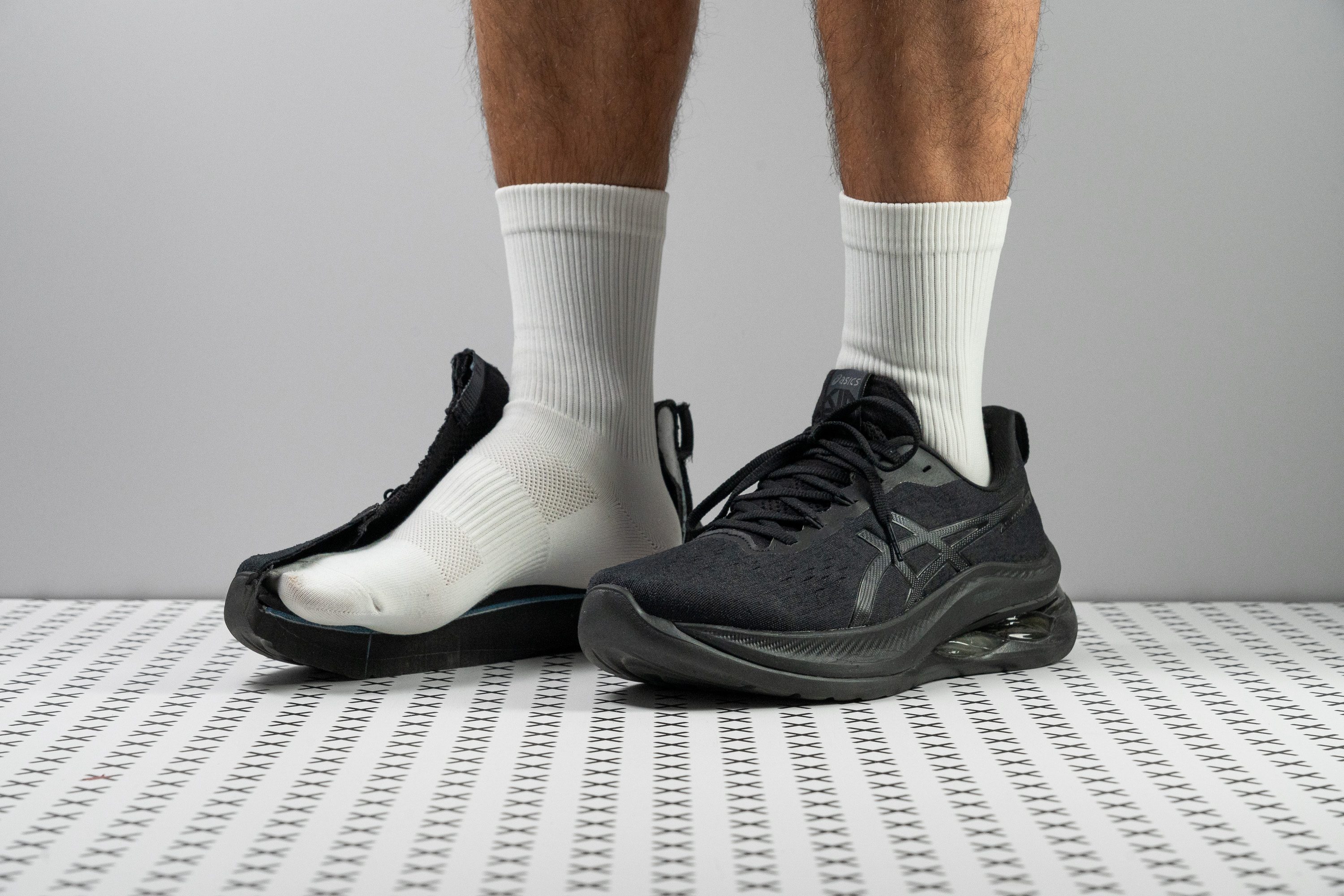Our verdict
Pros
- Deep, plush cushioning
- Rocker geometry for smooth transitions
- Excellent for cold weather
- Amazing stability
- High-quality upper
- Ideal for heel strikers
- Can be used as a sneaker or travel shoe
Cons
- Heavyweight build
- Not the most spacious toebox
- High retail price
- Low energy return
Audience verdict
Comparison
The most similar running shoes compared
+ + Add a shoe | |||||
|---|---|---|---|---|---|
| Audience score | 83 Good! | 83 Good! | 86 Good! | 89 Great! | |
| Price | £185 | £100 | £180 | £150 | |
| Pace | Daily running | Daily running | Daily running | Daily running | |
| Arch support | Neutral | Neutral | Neutral | Neutral | |
| Weight lab Weight brand | 11.4 oz / 322g 11.7 oz / 333g | 8.4 oz / 237g 9.2 oz / 260g | 10.5 oz / 299g 10.8 oz / 305g | 9.9 oz / 281g 10 oz / 284g | |
| Lightweight | ✗ | ✓ | ✗ | ✗ | |
| Drop lab Drop brand | 8.6 mm 8.0 mm | 8.1 mm 8.0 mm | 8.3 mm 8.0 mm | 8.9 mm 8.0 mm | |
| Strike pattern | HeelMid/forefoot | HeelMid/forefoot | HeelMid/forefoot | HeelMid/forefoot | |
| Size | True to size | True to size | True to size | True to size | |
| Midsole softness | Soft | Balanced | Balanced | Balanced | |
| Difference in midsole softness in cold | Small | Small | Small | Small | |
| Toebox durability | Decent | Decent | Decent | Decent | |
| Heel padding durability | Decent | Good | Good | Bad | |
| Outsole durability | Good | Good | Good | Bad | |
| Breathability | Moderate | Moderate | Moderate | Moderate | |
| Width / fit | Medium | Medium | Medium | Medium | |
| Toebox width | Medium | Medium | Medium | Medium | |
| Stiffness | Moderate | Moderate | Stiff | Moderate | |
| Torsional rigidity | Stiff | Stiff | Stiff | Stiff | |
| Heel counter stiffness | Stiff | Stiff | Stiff | Stiff | |
| Rocker | ✓ | ✗ | ✓ | ✓ | |
| Heel lab Heel brand | 38.8 mm 38.0 mm | 35.3 mm 35.0 mm | 42.7 mm 44.0 mm | 36.1 mm 37.0 mm | |
| Forefoot lab Forefoot brand | 30.2 mm 30.0 mm | 27.2 mm 27.0 mm | 34.4 mm 36.0 mm | 27.2 mm 29.0 mm | |
| Widths available | Normal | Normal | NormalWideX-Wide | Normal | |
| Orthotic friendly | ✓ | ✓ | ✓ | ✓ | |
| Season | All seasons | All seasons | All seasons | All seasons | |
| Removable insole | ✓ | ✓ | ✓ | ✓ | |
| Ranking | #265 Bottom 27% | #263 Bottom 28% | #173 Top 48% | #91 Top 25% | |
| Popularity | #297 Bottom 19% | #185 Bottom 49% | #18 Top 5% | #228 Bottom 38% |
Who should buy
The ASICS Gel Kinsei Max is a solid pick for:
- Loyal fans of ASICS' old-school GEL tech eager to enjoy it again in a premium daily trainer.
- Those seeking a comfort-focused shoe for jogging, walking, travel, and light workouts—packed with a towering stack for extra underfoot cushion.
- Casual runners with a generous budget who land on their heels and prioritise comfort.
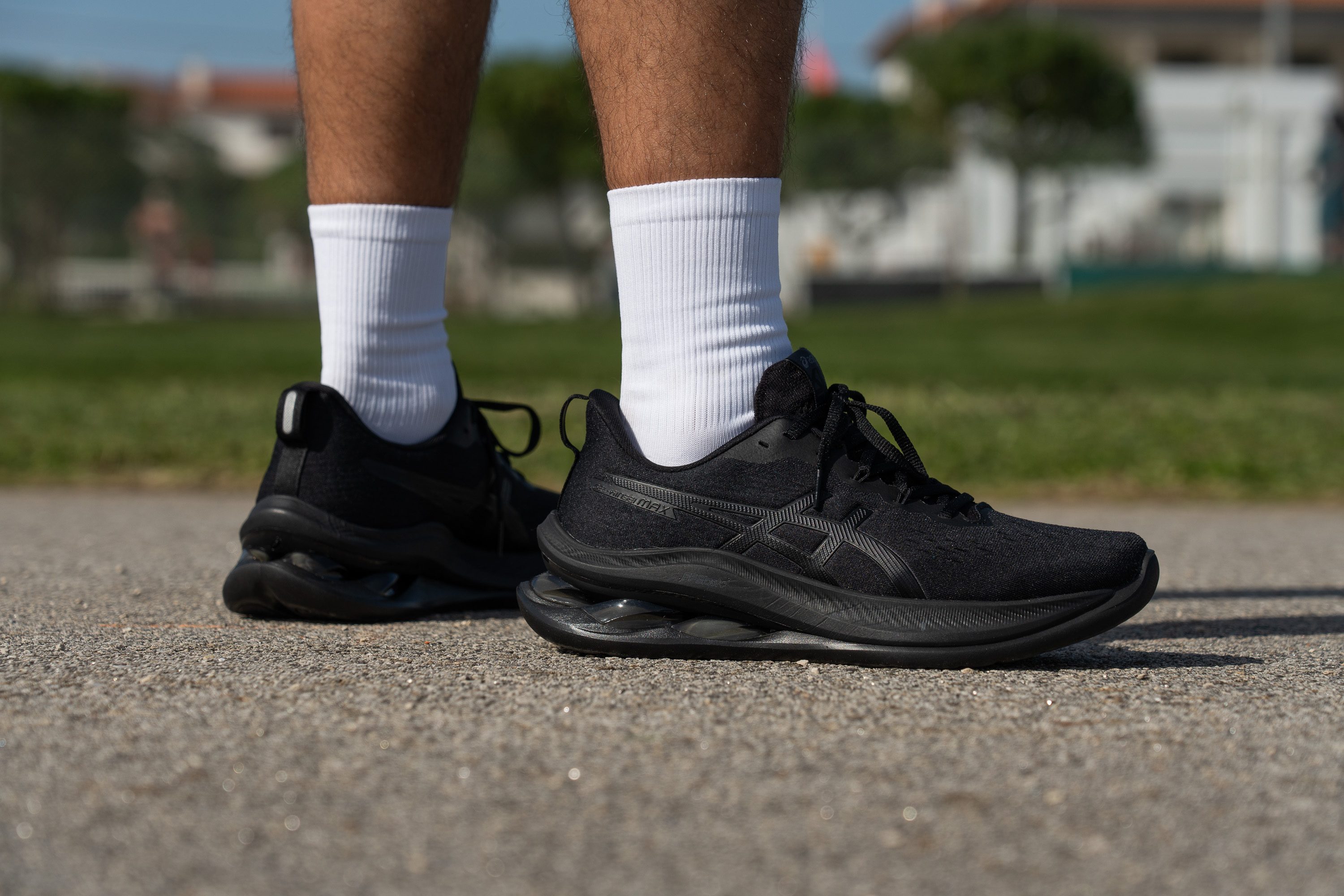
Who should NOT buy
We believe that the substantial weight of this shoe, detracts from its appeal as a modern running option. For those prioritising a lightweight experience, the ASICS Novablast 5 offers a more agile alternative at a lower price point.
Additionally, we think the ASICS Superblast 2, despite its similar price, provides enhanced responsiveness and reduced weight, making it a superior choice for runners seeking a more dynamic ride.
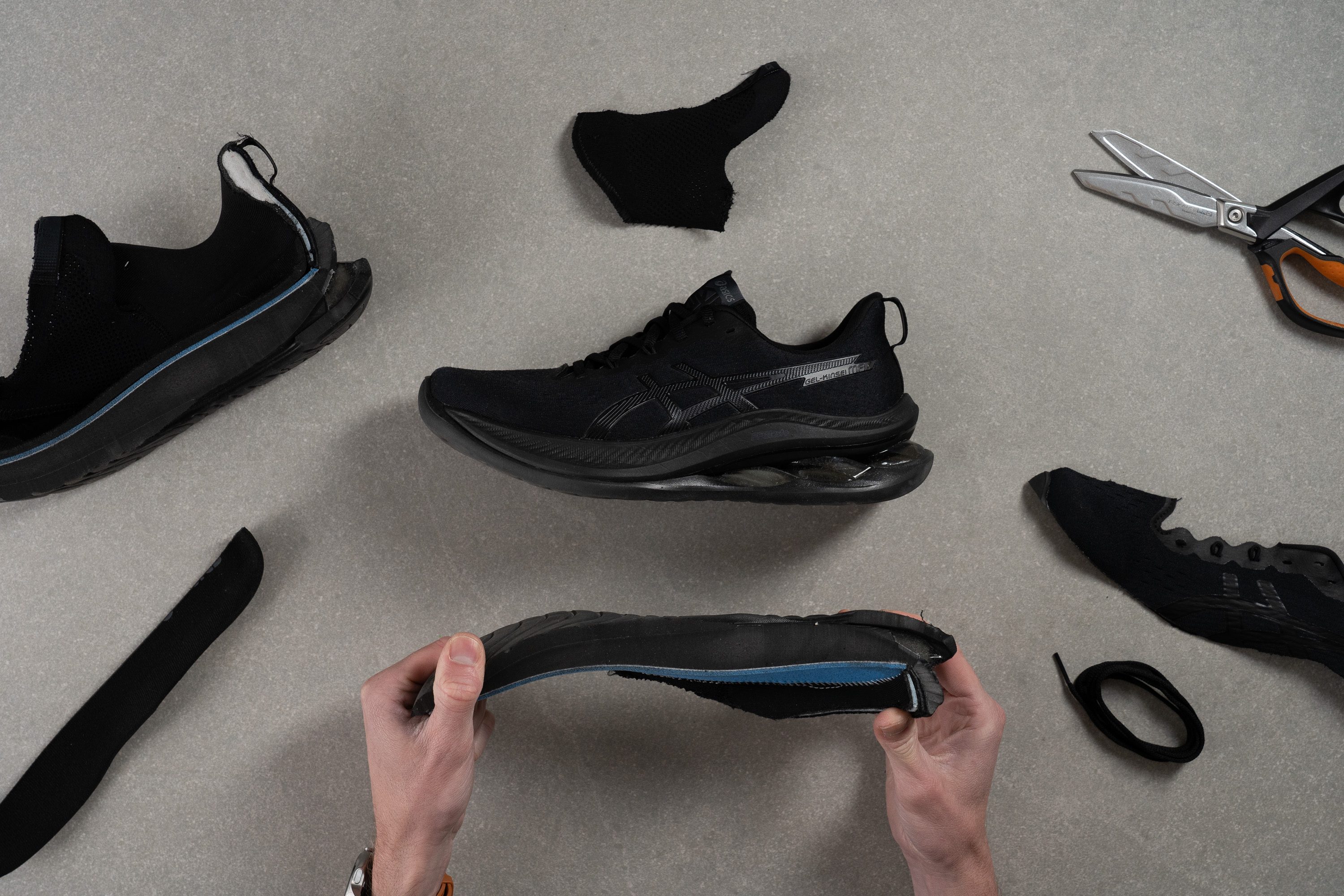
For those emphasising comfort without the added bulk, the ASICS Gel Nimbus 27 it's probably a more reasonable choice. Exploring options beyond ASICS, the HOKA Skyflow stands out as a fantastic alternative, combining a lighter construction with substantial cushioning.
Cushioning
Shock absorption
Shock absorption is impressive in the forefoot with 118 SA, but a bit underwhelming in the heel at 120 SA. That’s mainly due to the GEL piece in the back; it feels nice underfoot, yet doesn’t match foam's performance regarding impact dampening.
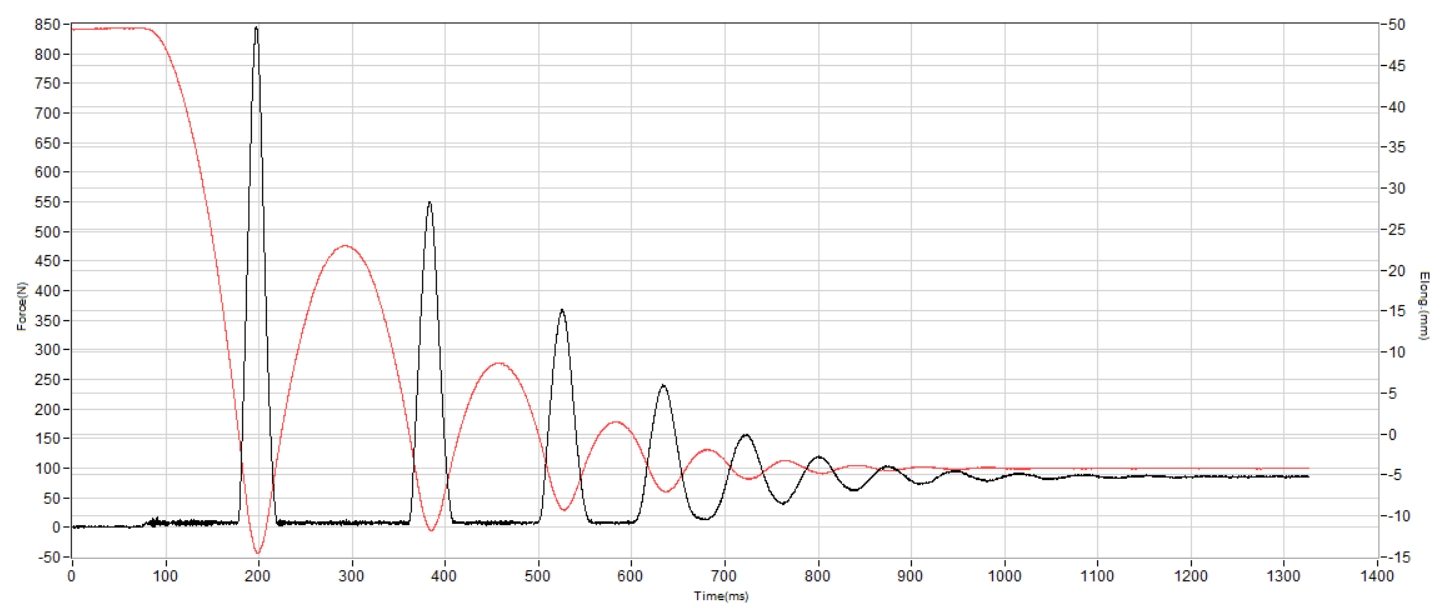
| Gel Kinsei Max | 120 SA |
| Average | 130 SA |
Energy return
Using the ASTM F1976 standard, we found that the Kinsei Max returns 56% of the energy from each step. That’s a mid-pack result and fairly average. However, this shoe doesn’t come at an average price, so we definitely expected it to clear the 60% mark.
For runners sticking to easy paces or using it for casual outings, that won’t be a big issue. But if you were considering this heavy-duty model for demanding long runs, it might be worth rethinking.
| Gel Kinsei Max | 56.0% |
| Average | 58.6% |
Heel stack
The Kinsei Max is a maximalist shoe—there’s no doubt about it. With a towering 38.8 mm stack and the signature GEL cushioning system, it delivers more-than-enough protection for heavier runners or anyone craving deep underfoot padding.
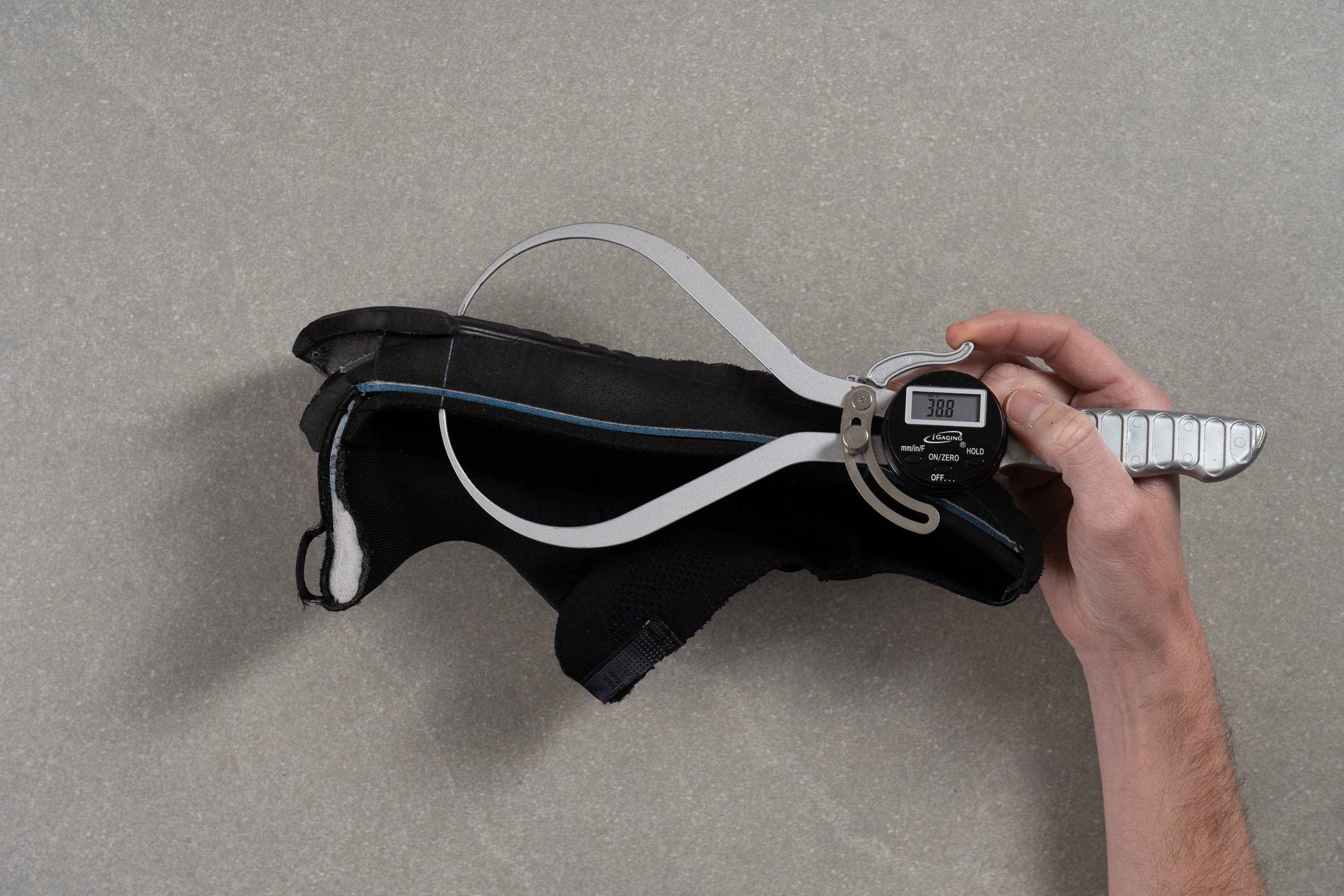
| Gel Kinsei Max | 38.8 mm |
| Average | 34.8 mm |
Forefoot stack
The forefoot also meets the maximalist standard, going past the 30 mm mark with a measured stack of 30.2 mm. This makes the shoe a solid choice for long runs, even for midfoot and forefoot strikers.
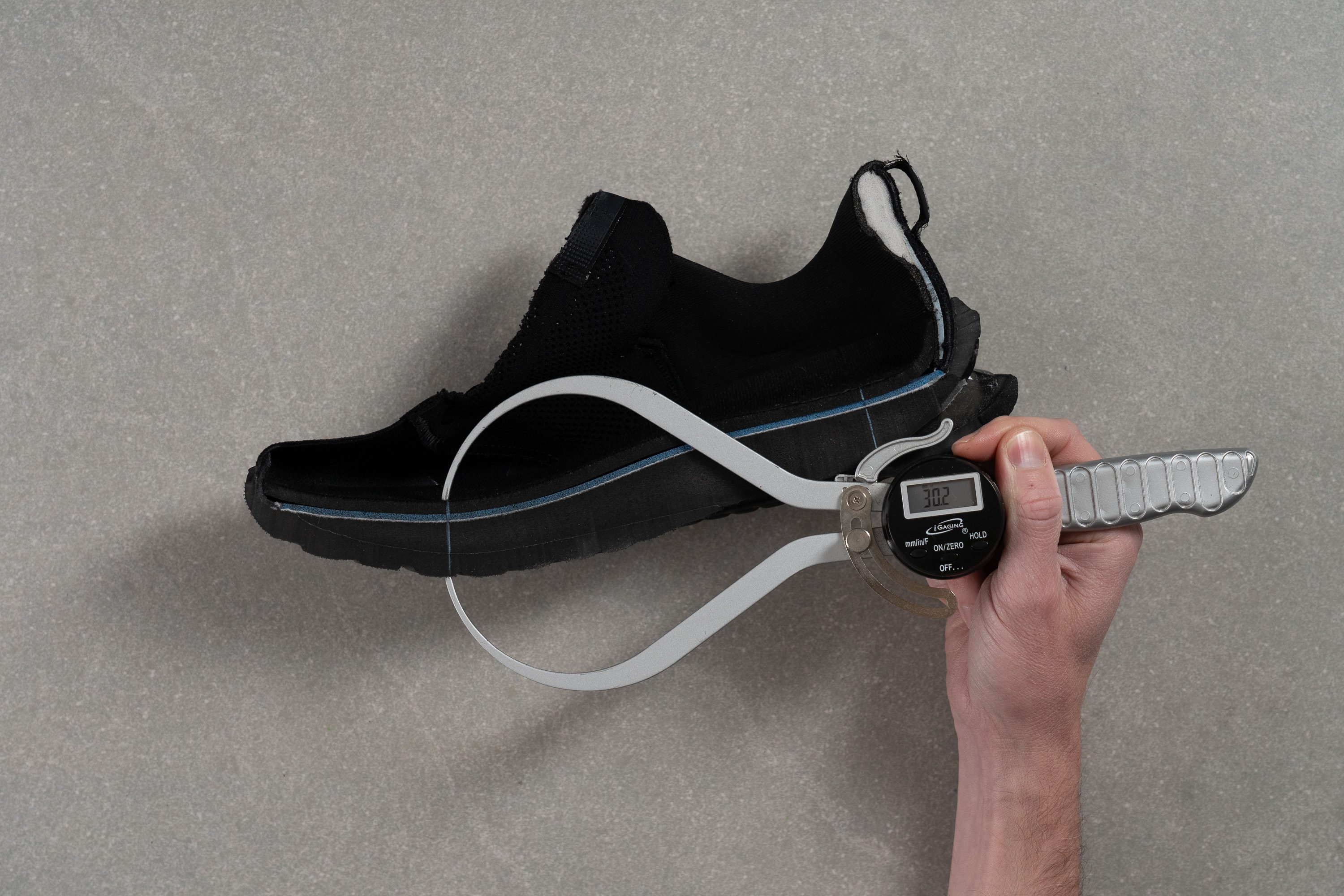
| Gel Kinsei Max | 30.2 mm |
| Average | 26.2 mm |
Drop
The difference between the forefoot and heel reveals an actual 8.6 mm drop, just 0.6 mm off ASICS' advertised figure. That’s impressively close, confirming you’ll get the same underfoot feel the brand states in their spec sheet.
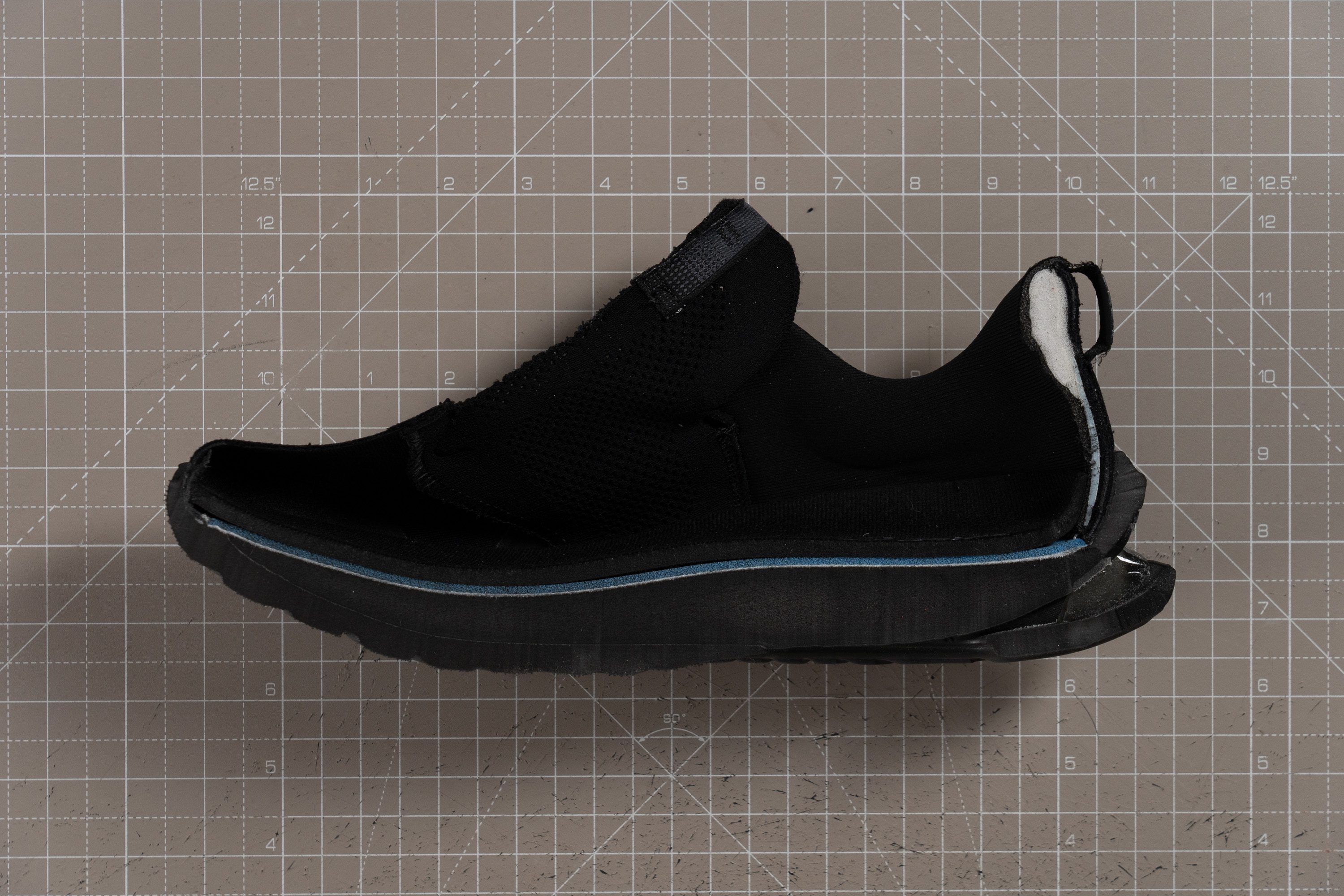
| Gel Kinsei Max | 8.6 mm |
| Average | 8.6 mm |
Midsole softness
The midsole of the Kinsei Max combines the classic GEL cushioning with a generous layer of FF Blast+ ECO, which is a moderately-soft foam also found in daily trainers like the ASICS GT 2000 13.
For a shoe in this price range, we expected something a bit more cutting-edge, but FF Blast+ ECO still delivers a reliable ride. We measured 19.1 HA on the durometer, but thanks to the GEL technology, it feels much softer than the number suggests.
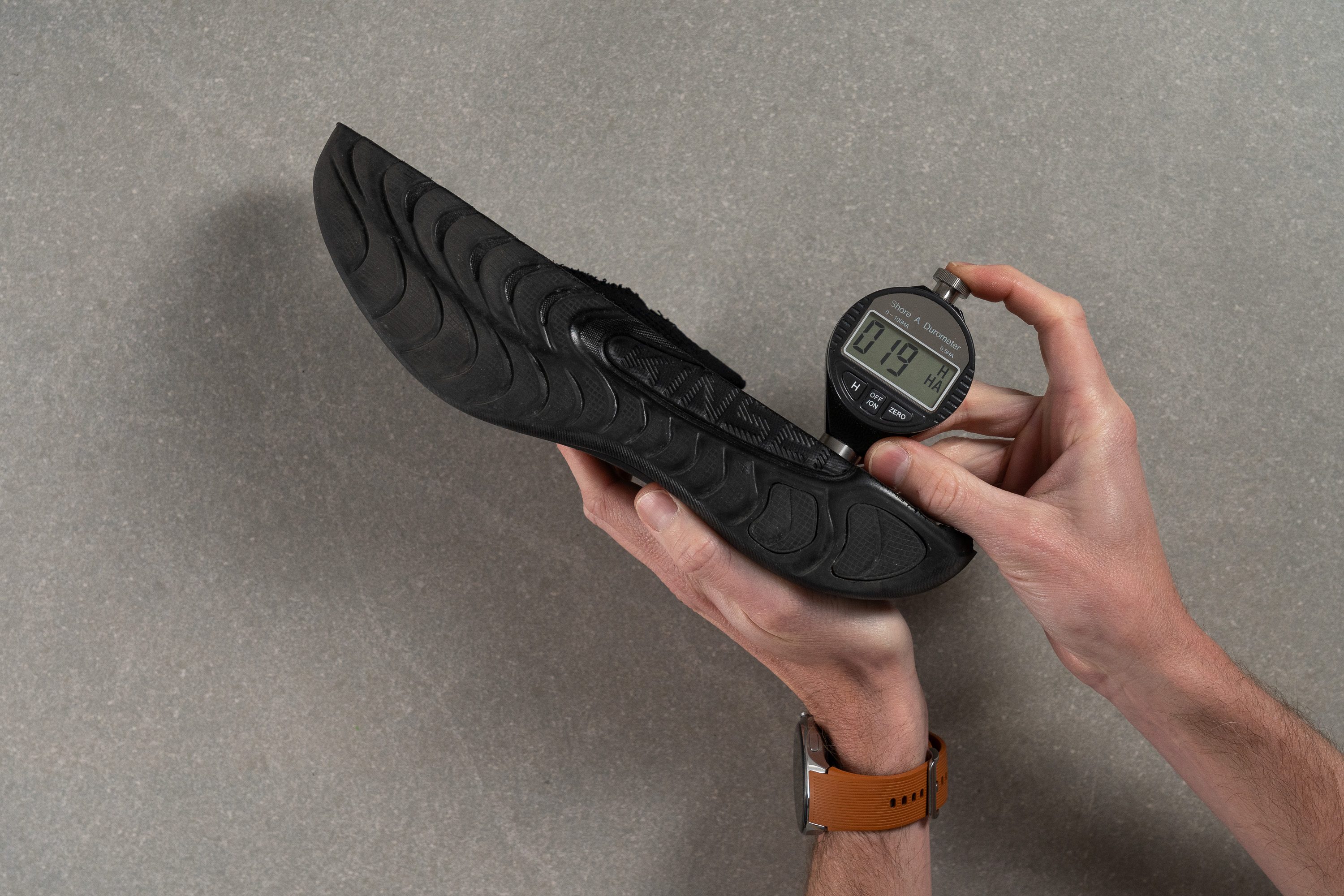
| Gel Kinsei Max | 19.1 HA |
| Average | 20.4 HA |
Rocker
The ASICS Gel Kinsei Max features a moderate rocker design that encourages smoother heel-to-toe transitions. Thanks to its flare-shaped heel and curved forefoot, we found it delivers an interesting rolling sensation, which is especially helpful for heel strikers.
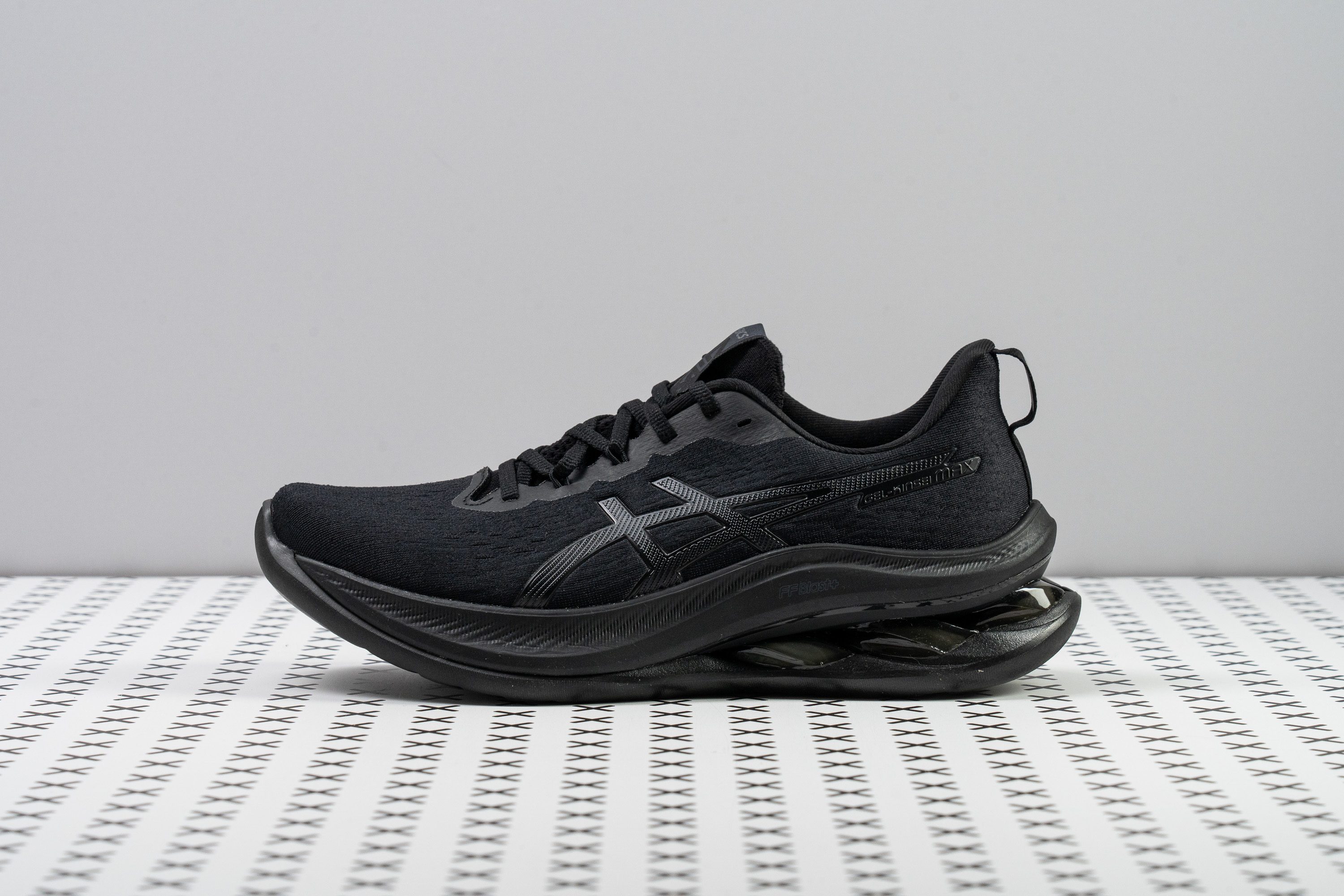
From our perspective, this rocker geometry shines on long runs, where rhythm matter more than raw speed. We tested it extensively, and with its heavy-duty build, it benefits greatly from having a curved midsole setup.
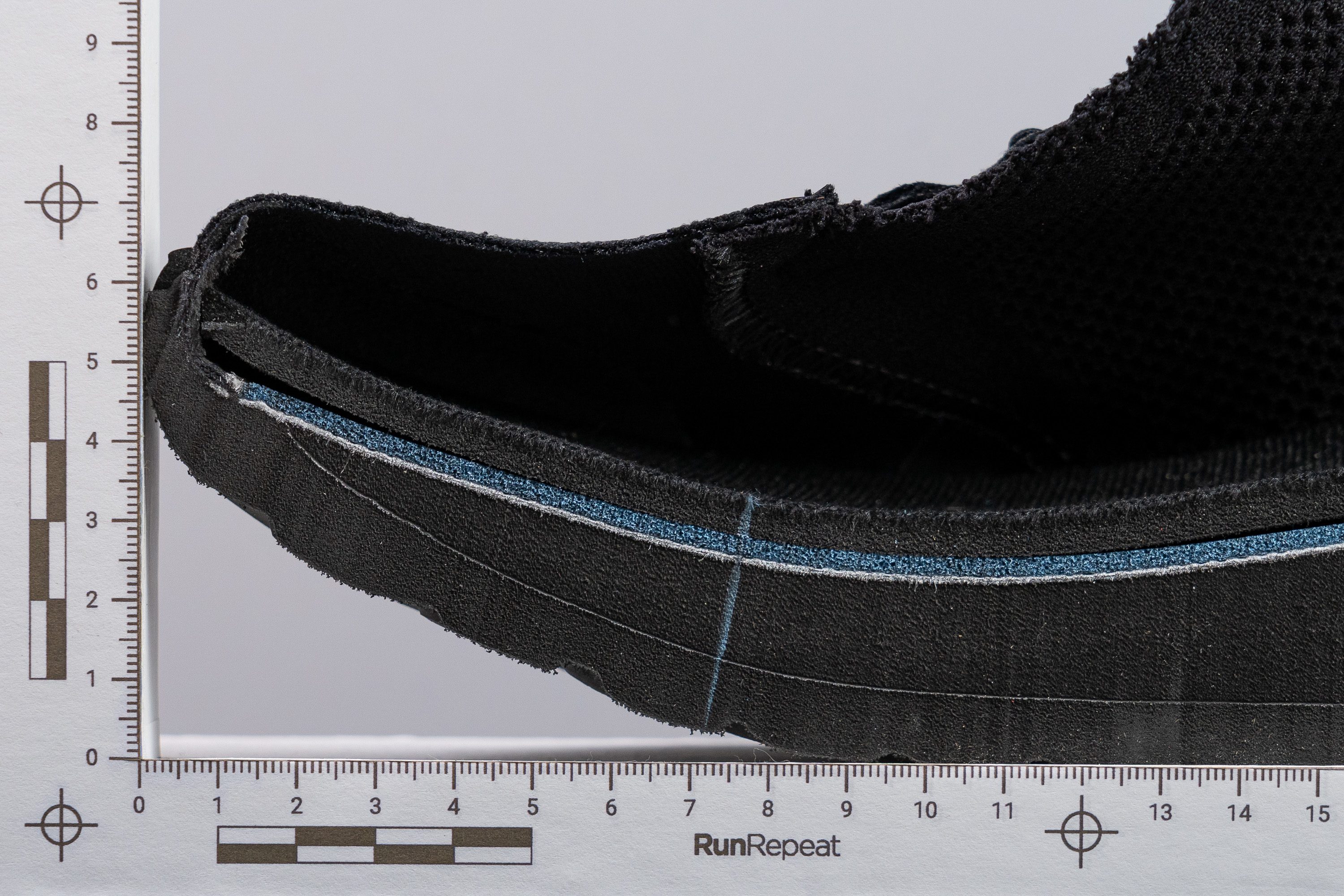
Hybrid Gel
Sporting a newer version called Hybrid Gel, ASICS refuses to let go of its long-standing proprietary tech despite its high weight and low rebound. In our runs, we discovered that it delivers cloud-plush landings as always, but definitely lacks any energetic bounce.
Size and fit
Size
ASICS Gel Kinsei Max fits true to size (41 votes).
Width / Fit
The fit of the Gel Kinsei Max caught us off guard. From its oversized look, we expected a roomy fit, but that spacious feel never showed up during our runs.
After testing, we discovered through our gel mould that the maximum width reached only 93.4 mm. That’s narrower than most average daily trainers and makes this shoe better suited for those who prefer a secure, race-inspired fit or have naturally slim feet.
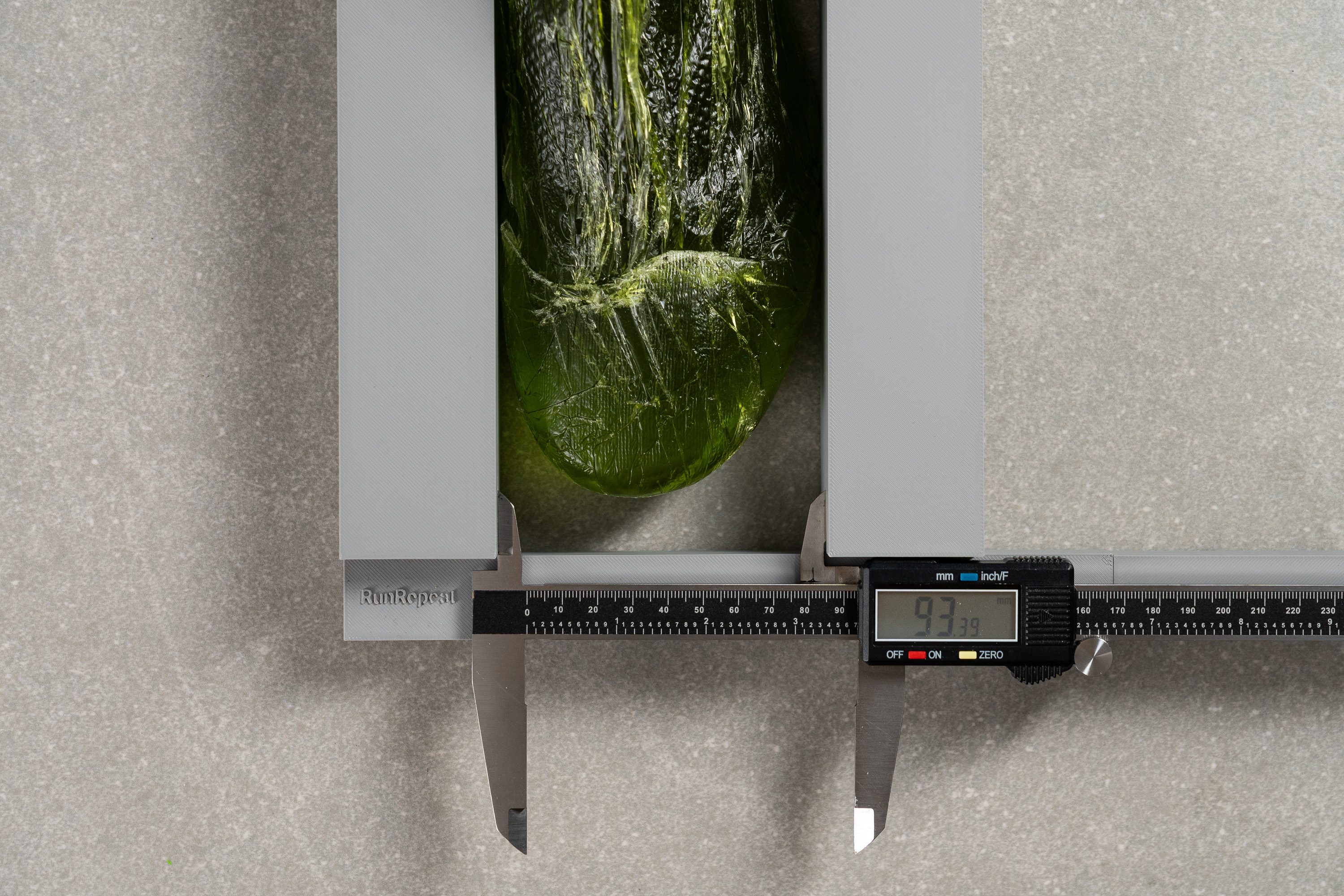
| Gel Kinsei Max | 93.4 mm |
| Average | 95.1 mm |
Toebox width
At 73.8 mm, the toebox leans toward an average fit, but it still features an obvious taper that doesn’t follow the natural toe shape, so you’ll need to be at peace with that.
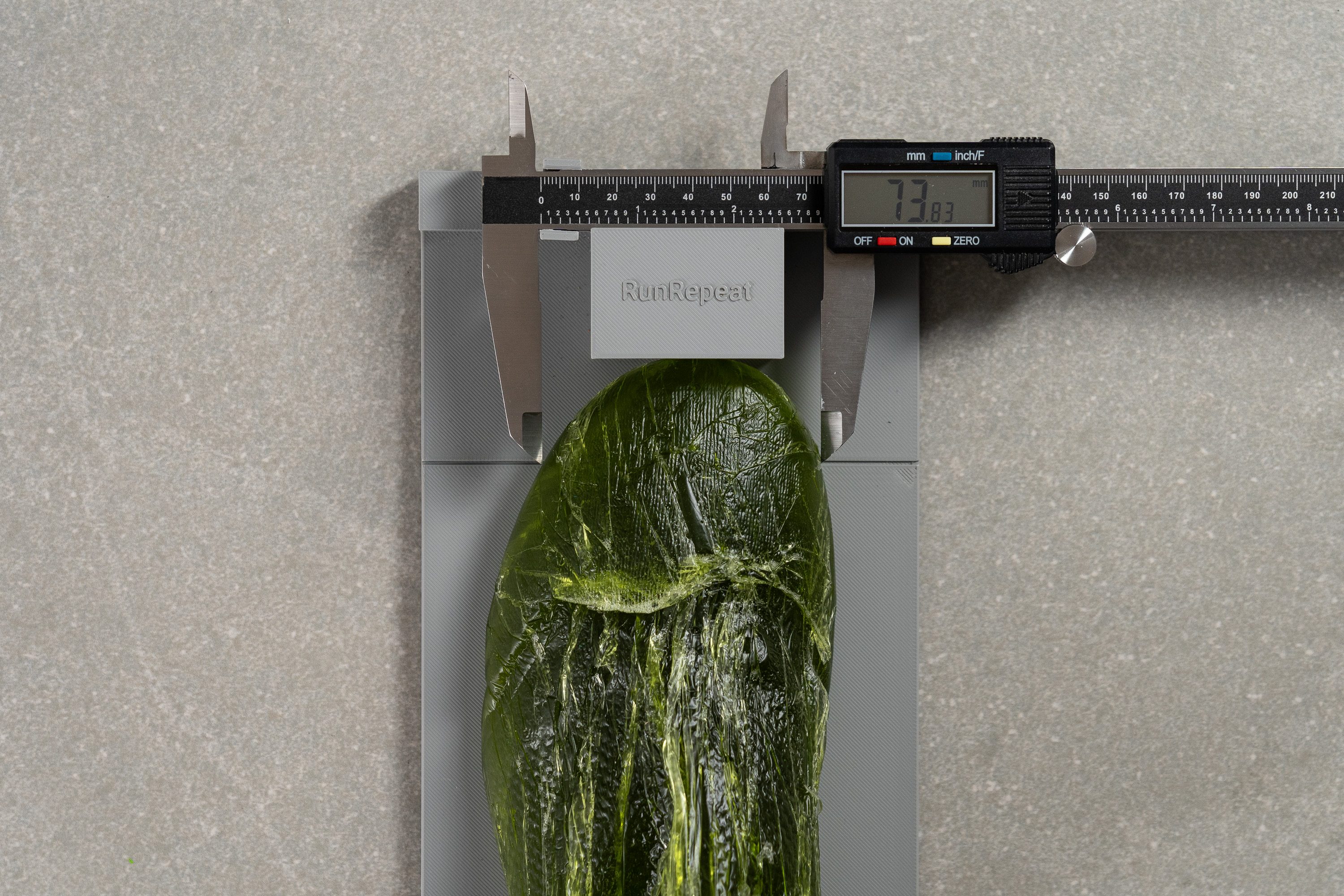
| Gel Kinsei Max | 73.8 mm |
| Average | 73.3 mm |
Toebox height
In terms of vertical room for the toes, the Kinsei Max truly lives up to its name.
With 30.3 mm of clearance, it’s an upper that won’t press down or cramp your toes from above.
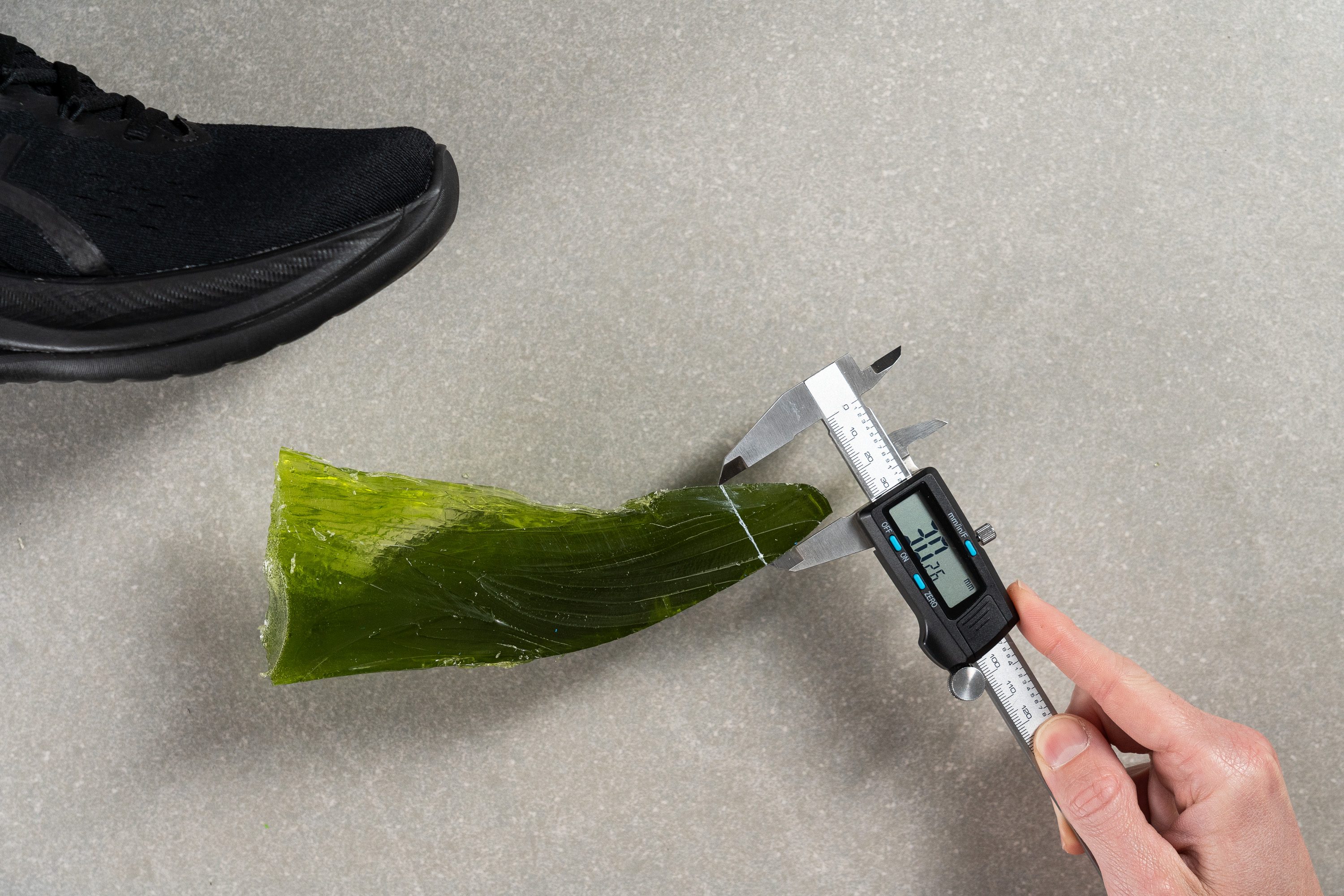
| Gel Kinsei Max | 30.3 mm |
| Average | 27.1 mm |
Traction / Grip
Traction test
The ASICS Gel Kinsei Max scored just 0.33 in our grip test—decent for dry roads but a bit underwhelming on wet ones. Given the premium price tag, we found this low-friction performance particularly frustrating.
| Gel Kinsei Max | 0.33 |
| Average | 0.48 |
Outsole design
Just like the rest of the Kinsei Max, this outsole takes a different path with an offbeat design. ASICS went with thick layer of FF Blast rubber to create extra-smooth landings and topped it off with only three small pieces of AHAR+ rubber in high-impact zones of the heel.
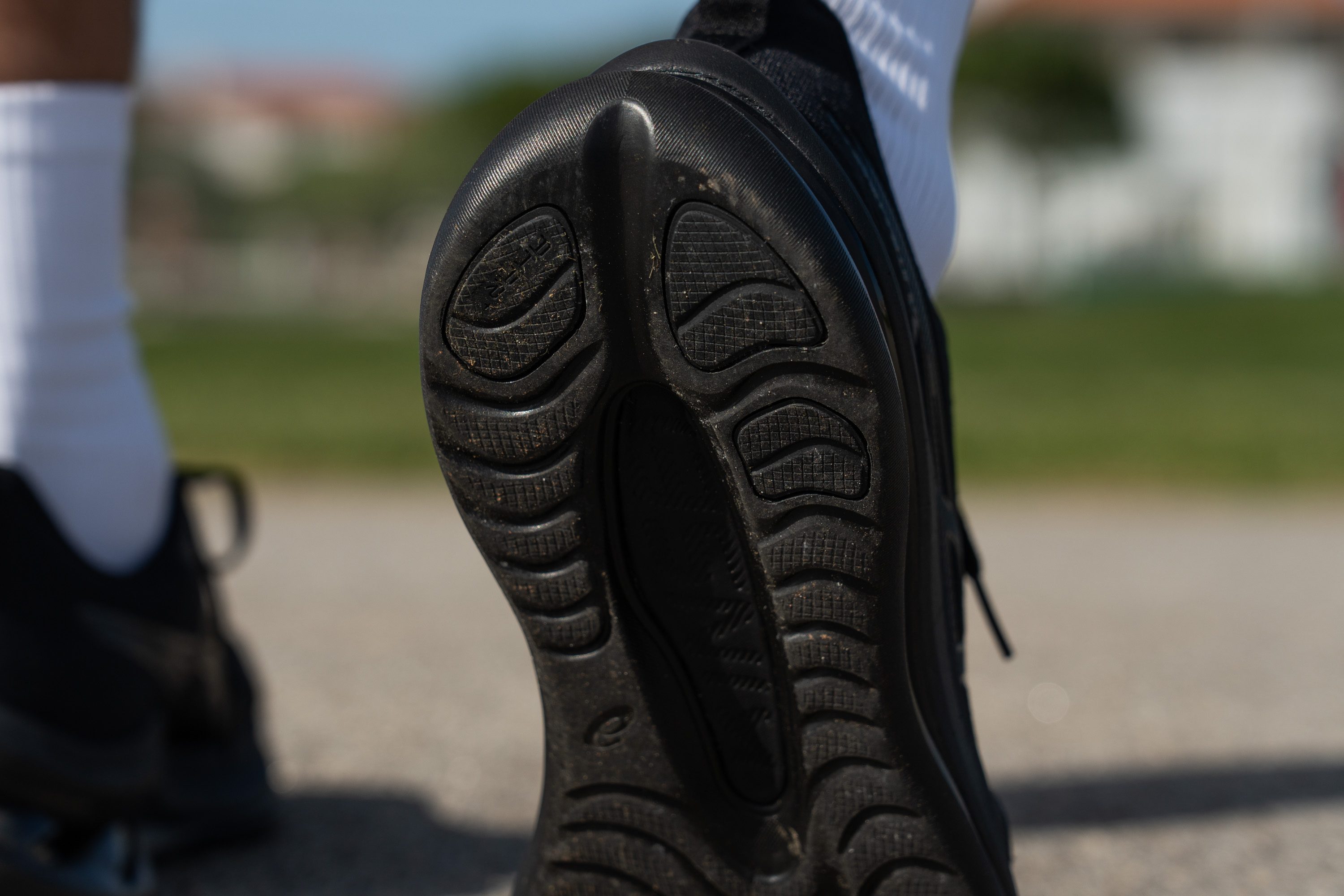
Flexibility / Stiffness
While the Kinsei Max is incredibly rigid when twisted, we were relieved to find it’s much more forgiving in longitudinal flex. Scoring 14.4N, it works surprisingly well for daily runs and even some casual walking.
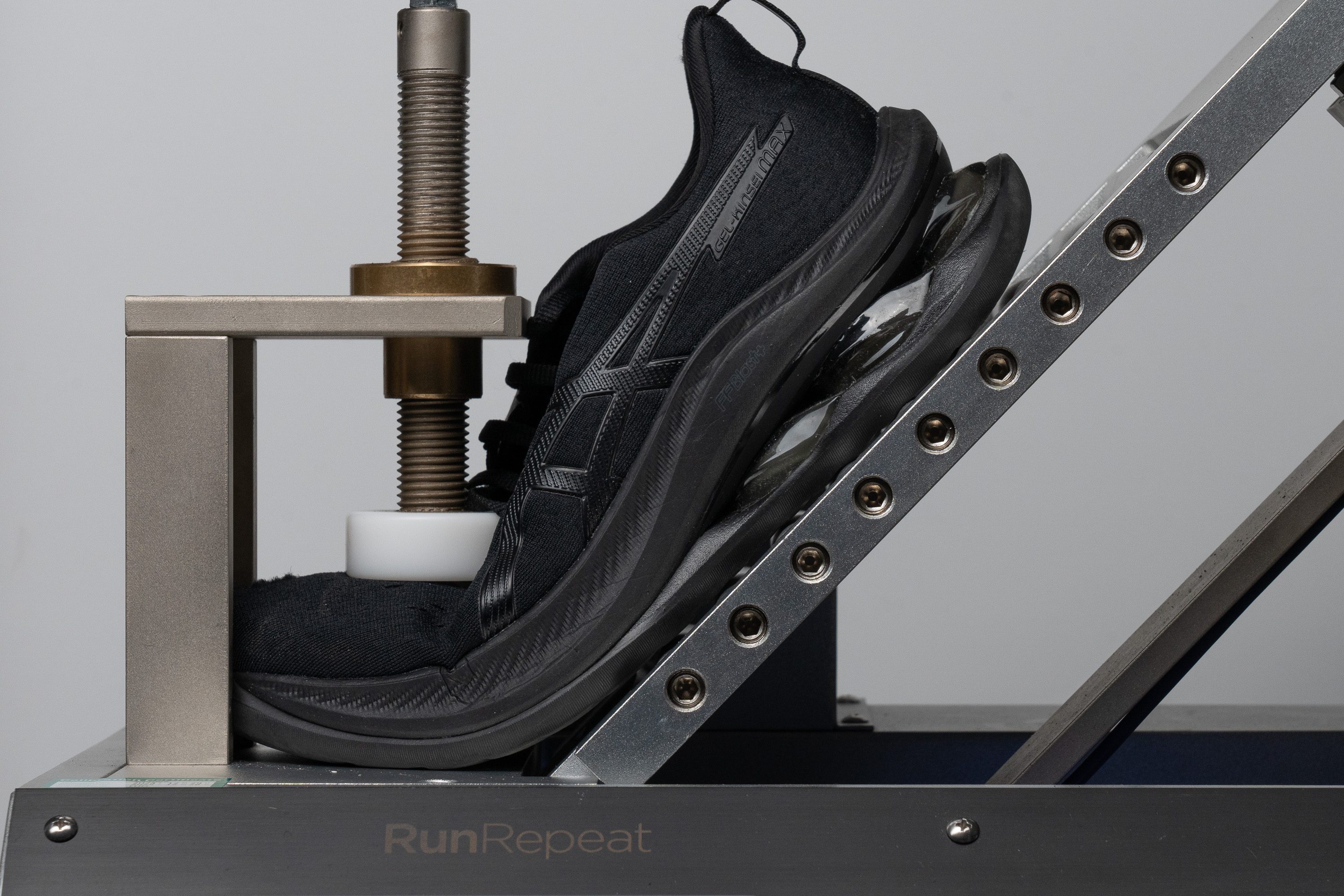
| Gel Kinsei Max | 14.4N |
| Average | 15.3N |
Weight
One of the things we dislike most during lab testing is when a shoe looks feather-light but turns out to be a brick. That’s definitely not the case with the Kinsei Max: it looks heavy and delivers on that impression.
In fact, at 11.35 oz or 322g, it's one of the heaviest shoes we've tested. We found its tank-like build hard to overlook, and we’re not going to sugarcoat it. If you're into comfort and don’t care about weight, it might be fine—but otherwise, this weighty monster won’t work for you.
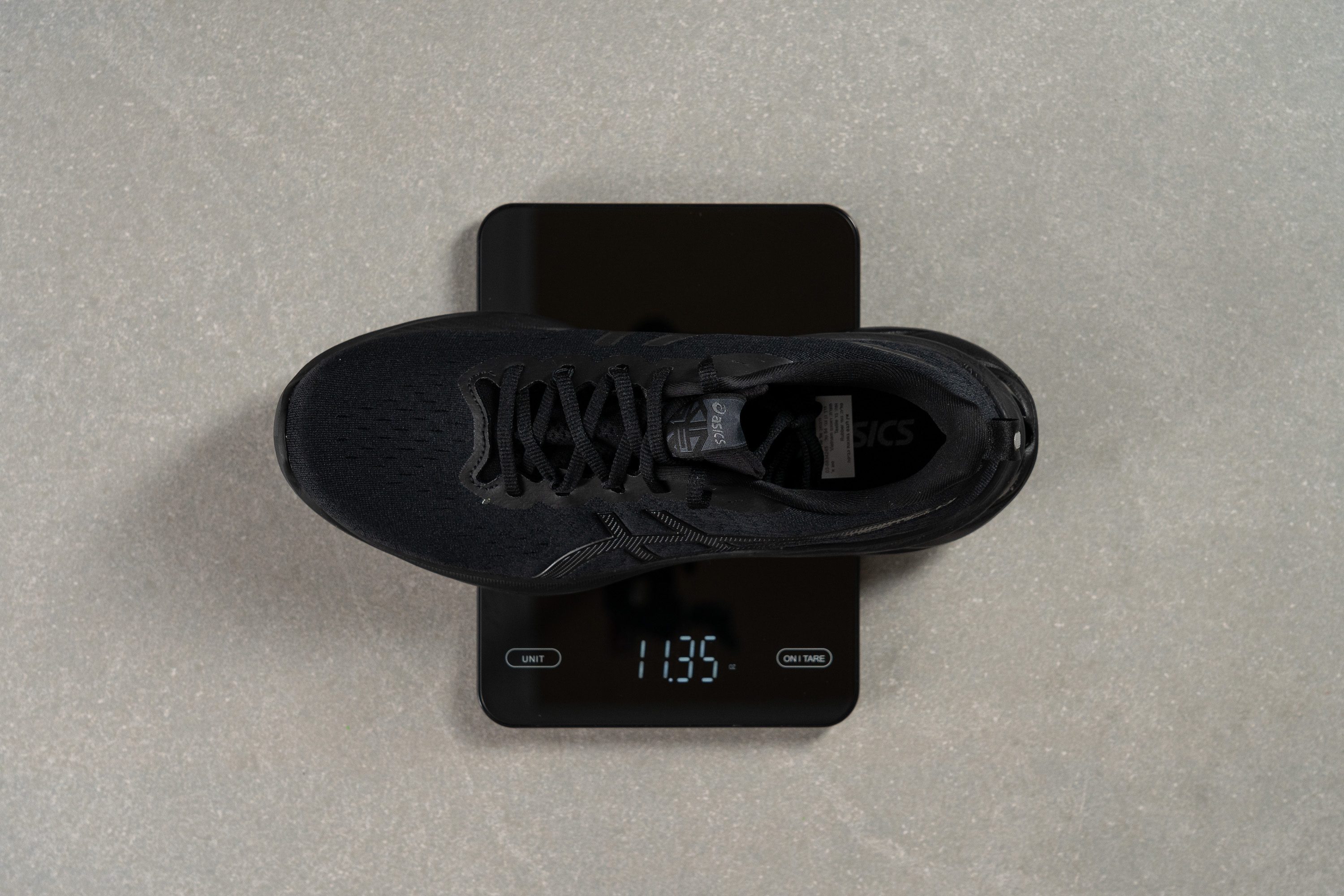
| Gel Kinsei Max | 11.4 oz (322g) |
| Average | 9.3 oz (264g) |
Breathability
Achieving a balance between breathability, comfort, and durability is often challenging, and ASICS aimed for a middle ground with the Kinsei Max.
We settled on a 3/5 score after analysing this shoe with our smoke machine. That's not a bad outcome, though at the price of this shoe, some may have expected better airflow for summer runs.
When we moved the upper over the light, it became clear to us that ASICS engineered this shoe as the opposite of most models—ventilation is prominently on the tongue but scarce on the toebox. Curious.
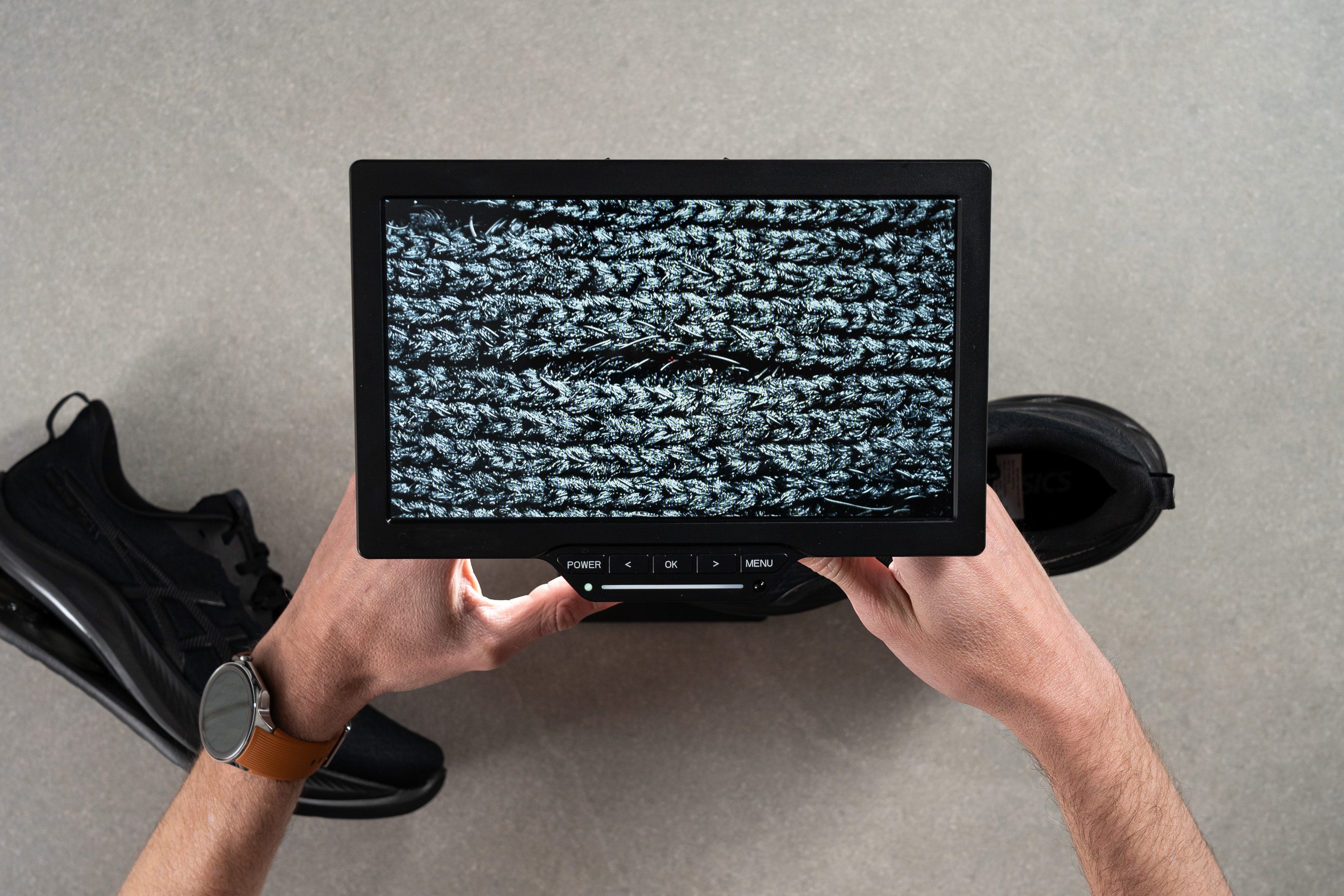
We confirmed the lack of airflow in the toebox with our microscope. While there are some openings, those are blocked because the secondary layer is not perforated.
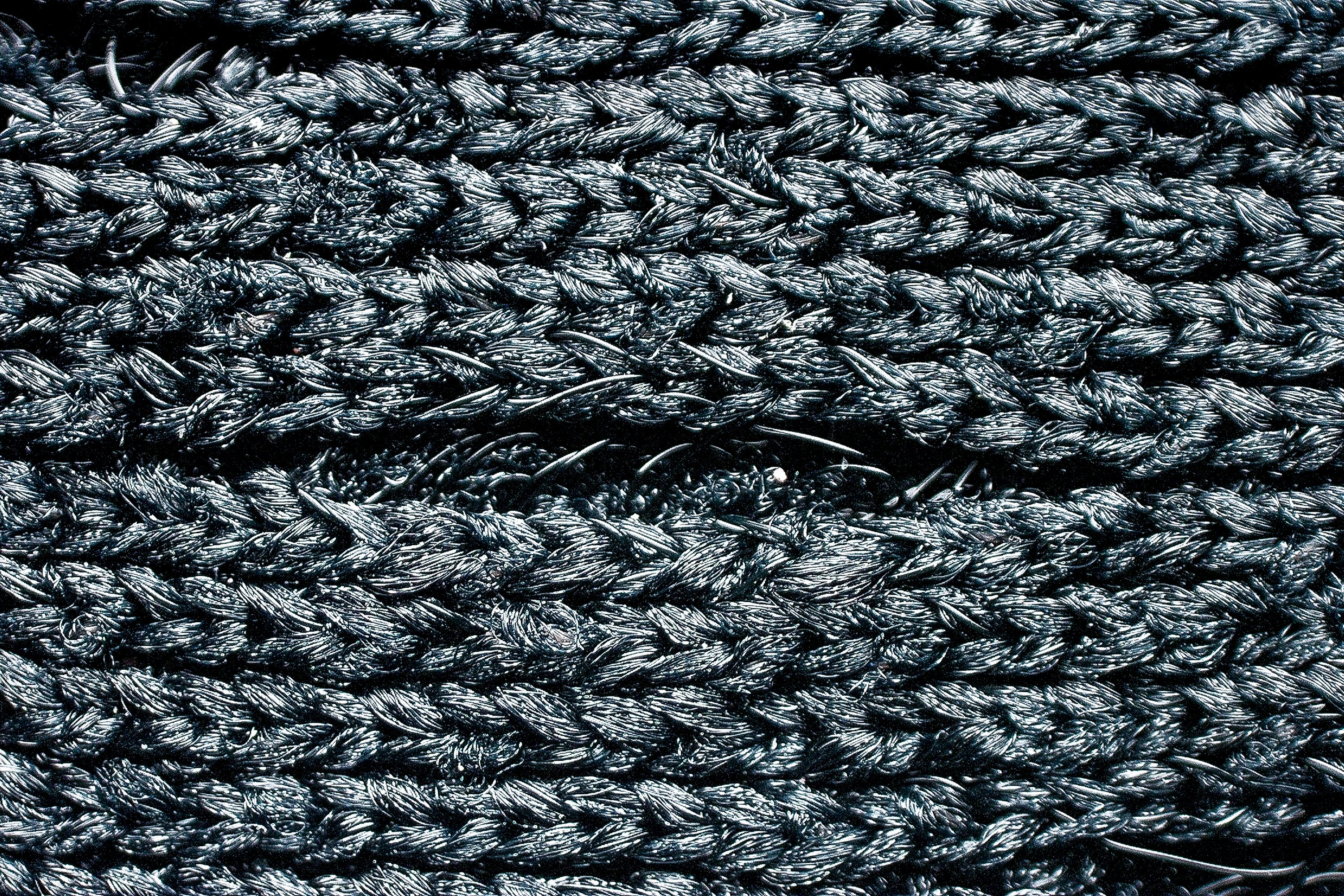
In fact, while most maximalist shoes usually have plush tongues, the Kinsei Max has a thin one. What a weird shoe!
| Gel Kinsei Max | 3 |
| Average | 3.7 |
Stability
Lateral stability test
We found solid stability in the Kinsei Max despite its towering build, though it didn’t catch us off guard. The shoe is loaded with tweaks that help keep the ride centered and steady!
Torsional rigidity
One of the key stability tricks is the sky-high torsional rigidity we discovered while trying to twist the shoe. It scored 5/5, behaving laterally like a carbon-plated racer. This setup keeps the ride centered and motion-guided, but it also takes away from natural foot movement.
| Gel Kinsei Max | 5 |
| Average | 3.5 |
Heel counter stiffness
Another trick pulled from ASICS’ stability playbook—another 5 out of 5. Runners who dislike stiff heel counters won’t enjoy the Kinsei Max either, as it feels like a block of stone locking the heel!
| Gel Kinsei Max | 5 |
| Average | 2.9 |
Midsole width - forefoot
This shoe also felt impressively stable thanks to its extra-wide midsole, offering a jumbo-sized landing platform for both midfoot and forefoot strikers. We measured 120.0 mm, but it felt even broader during our runs.
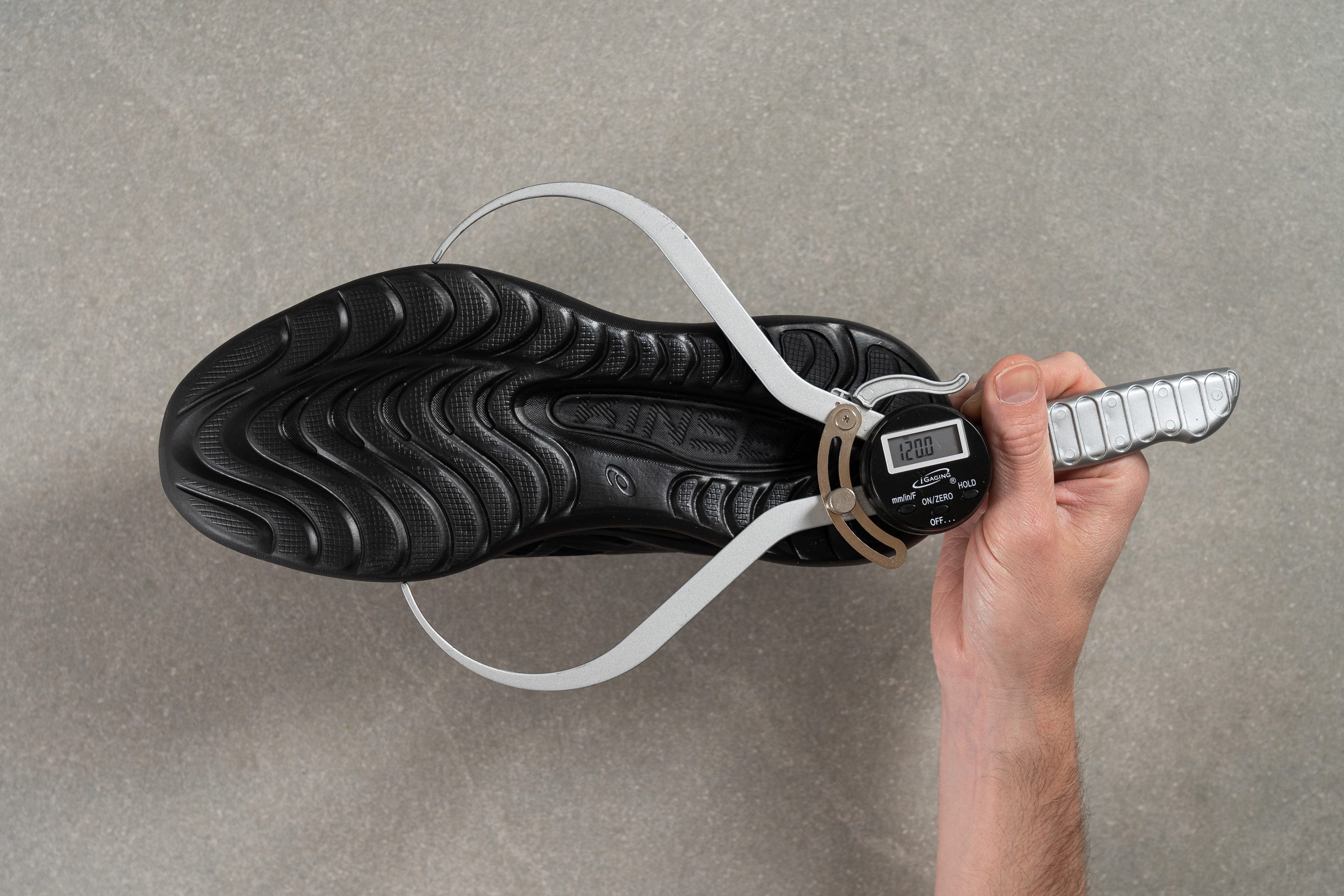
| Gel Kinsei Max | 120.0 mm |
| Average | 114.3 mm |
Midsole width - heel
We got the same feeling in the heel, and our digital calipers confirmed it with a measurement of 95.9 mm—once again placing the Kinsei Max on the wider side of the spectrum.
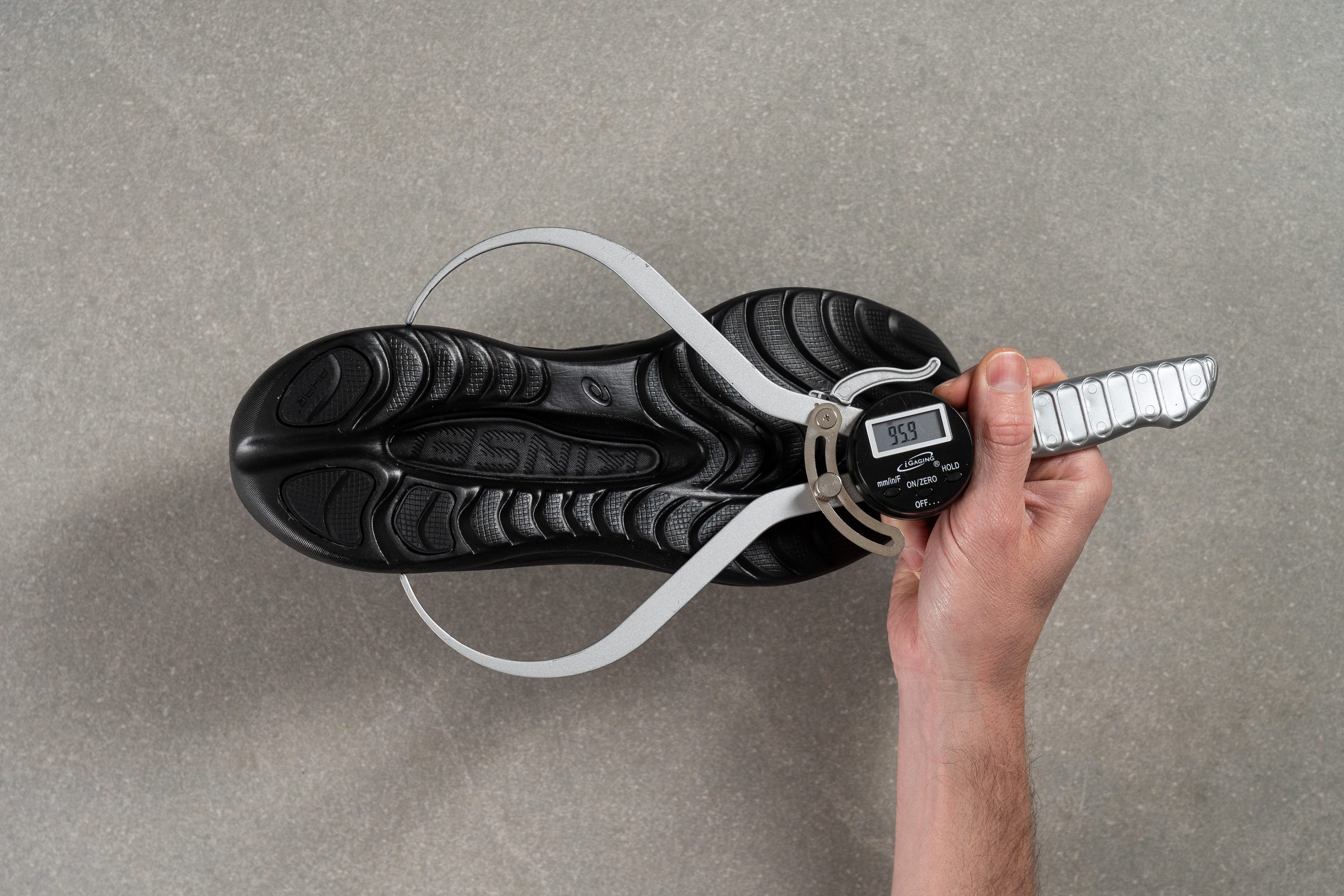
| Gel Kinsei Max | 95.9 mm |
| Average | 90.7 mm |
Durability
Toebox durability
Thanks to its thicker upper, the Kinsei Max earned a solid 3/5 score in our initial Dremel test—outperforming many shoes with thinner, less durable materials.
| Gel Kinsei Max | 3 |
| Average | 2.6 |
Heel padding durability
However, the heel counter left us underwhelmed, scoring only 2/5. It’s not a deal-breaker for those eyeing this shoe, but at this price point, we definitely expected a more durable result.
| Gel Kinsei Max | 2 |
| Average | 3.4 |
Outsole hardness
Flipping the shoe to check the outsole, we recorded an average 82.2 HC reading—nothing unusual there. However, just like the rest of the Kinsei Max, this outsole takes a different path with an offbeat design.

ASICS went with thick layer of FF Blast rubber to create extra-smooth landings and topped it off with only three small pieces of AHAR+ rubber in high-impact zones of the heel.
Based on our testing and past experience with similar hybrid-rubber setups—like on the Cumulus 26—heel strikers should see standard wear, but others may see faster-than-average outsole erosion.
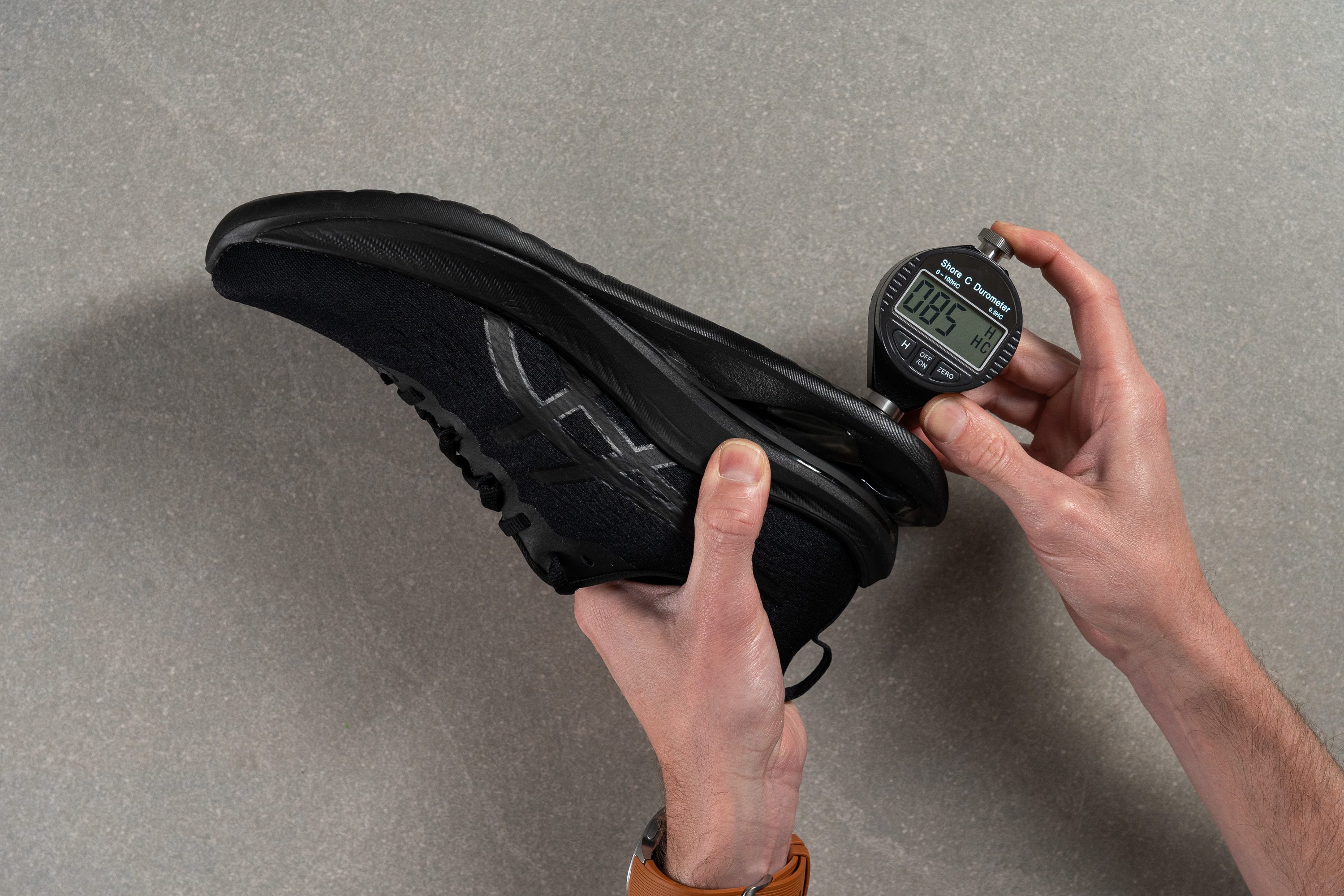
| Gel Kinsei Max | 82.2 HC |
| Average | 79.2 HC |
Outsole durability
The AHAR+ pieces proved tough, our Dremel shaved off just 0.6 mm after applying the same pressure and intensity we use on every outsole.
| Gel Kinsei Max | 0.6 mm |
| Average | 1.1 mm |
Outsole thickness
While it's true that a rubberized EVA outsole wears down super fast, ASICS at least packed it with a huge piece to make up for it. We clocked a record-breaking 8.4 mm!
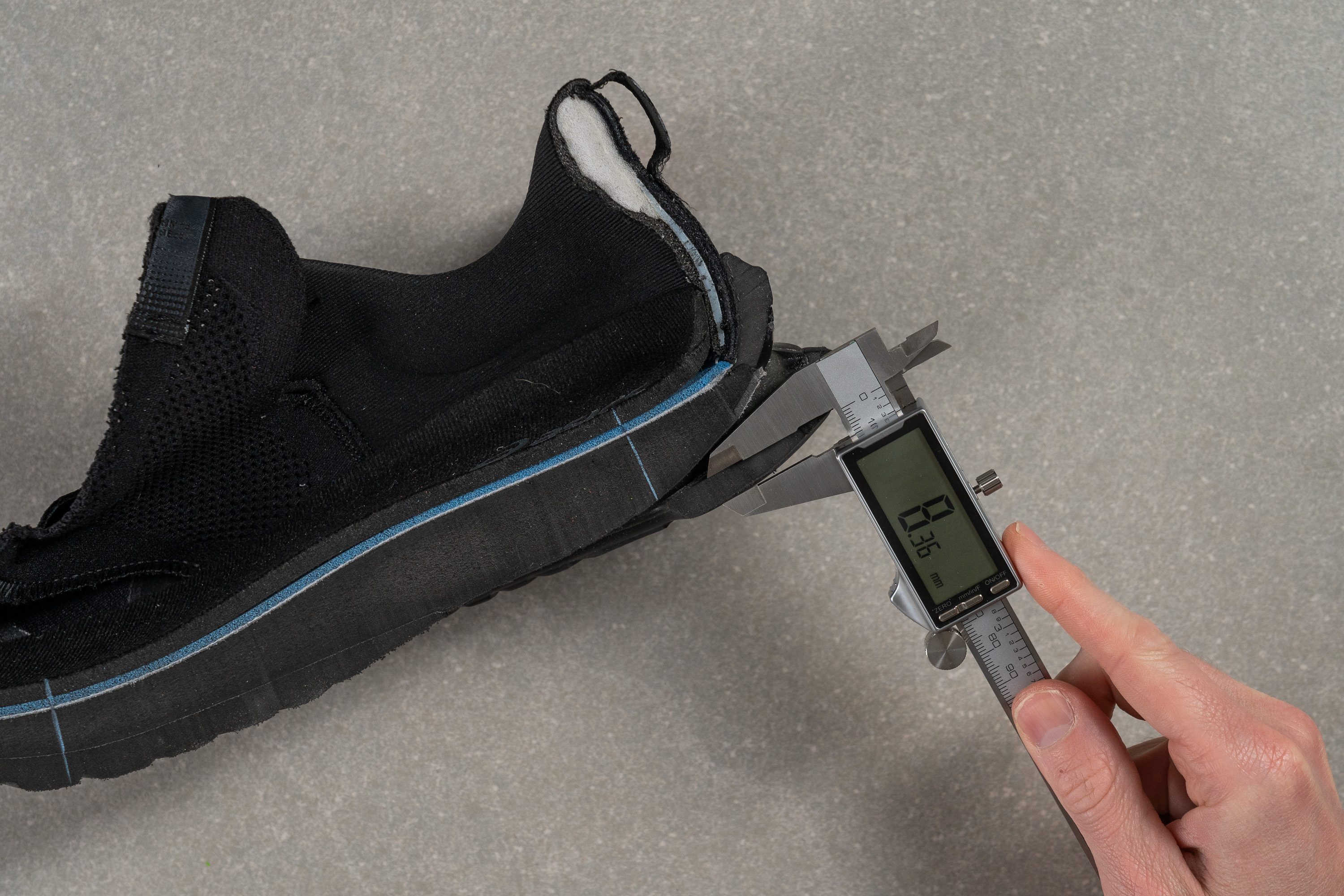
| Gel Kinsei Max | 8.4 mm |
| Average | 3.2 mm |
Misc
Insole thickness
Despite being a bit pricier than other shoes, the Kinsei Max features a standard 4.4 mm insole that feels fairly average underfoot.
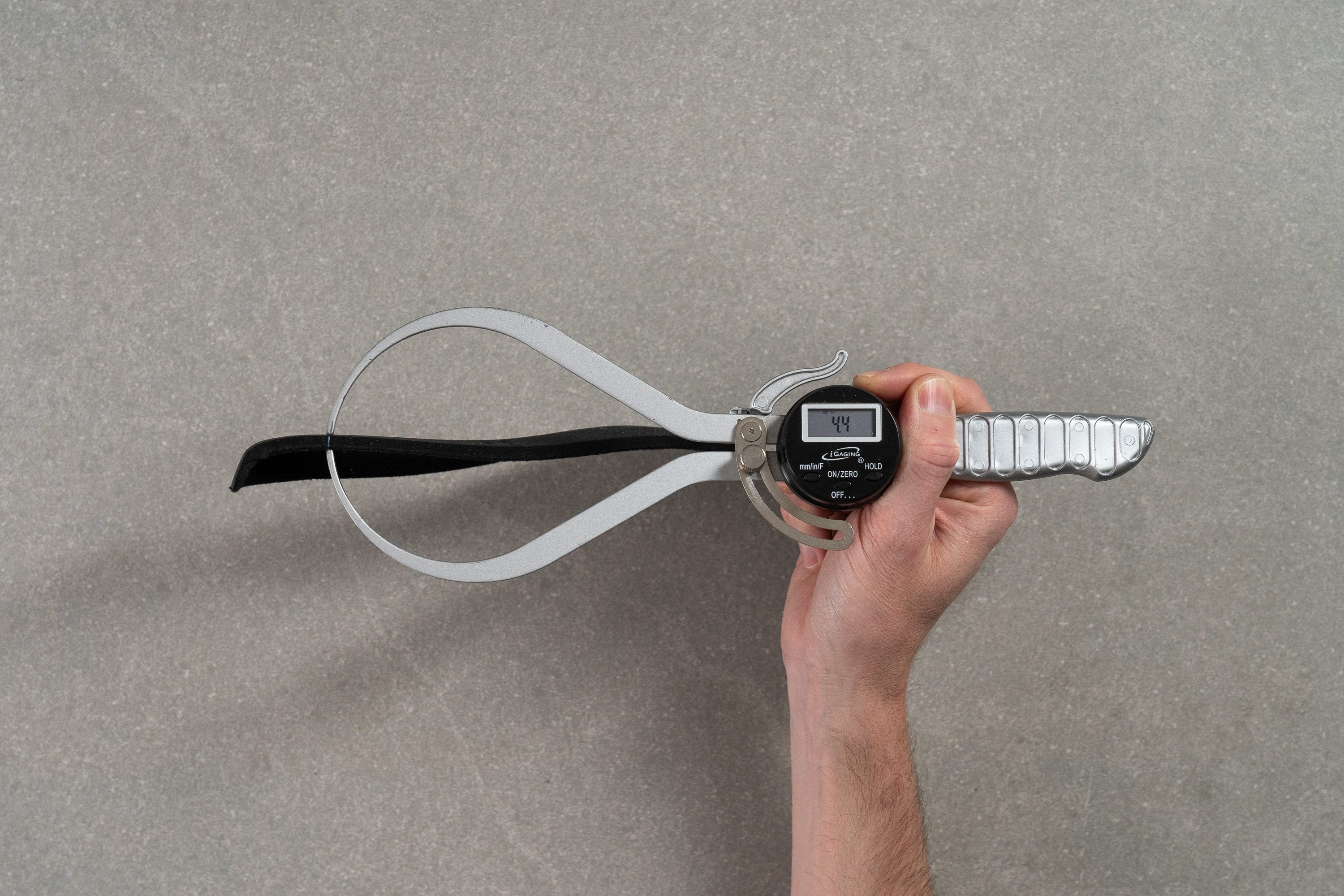
| Gel Kinsei Max | 4.4 mm |
| Average | 4.5 mm |
Removable insole
The insole slides out easily and can be swapped in just seconds.
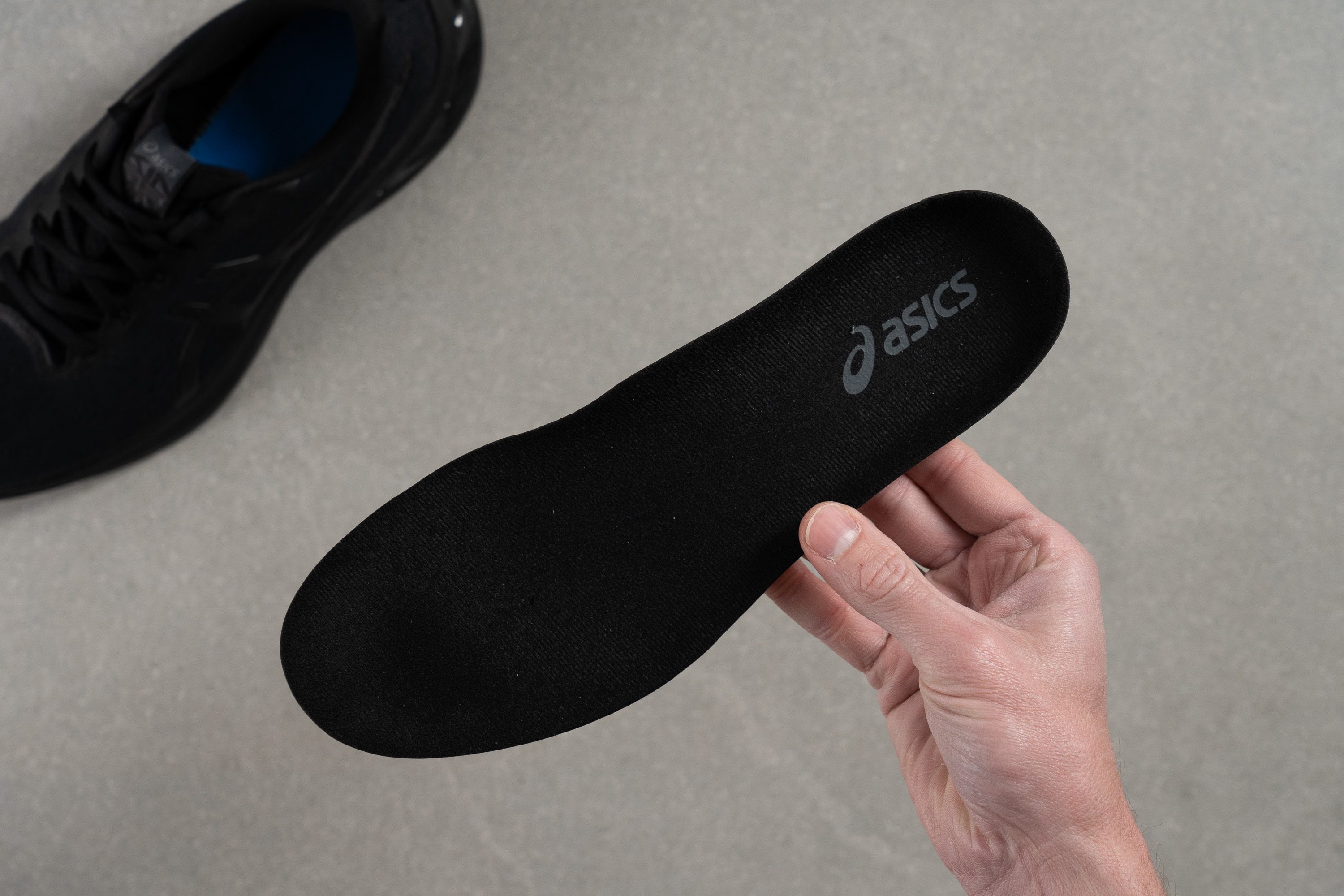
| Gel Kinsei Max | Yes |
Midsole softness in cold (%)
The Kinsei Max performed well in our cold-resistance test, firming up by just 16% after 20 minutes in the freezer. That’s a good result for runners training in cooler climates.
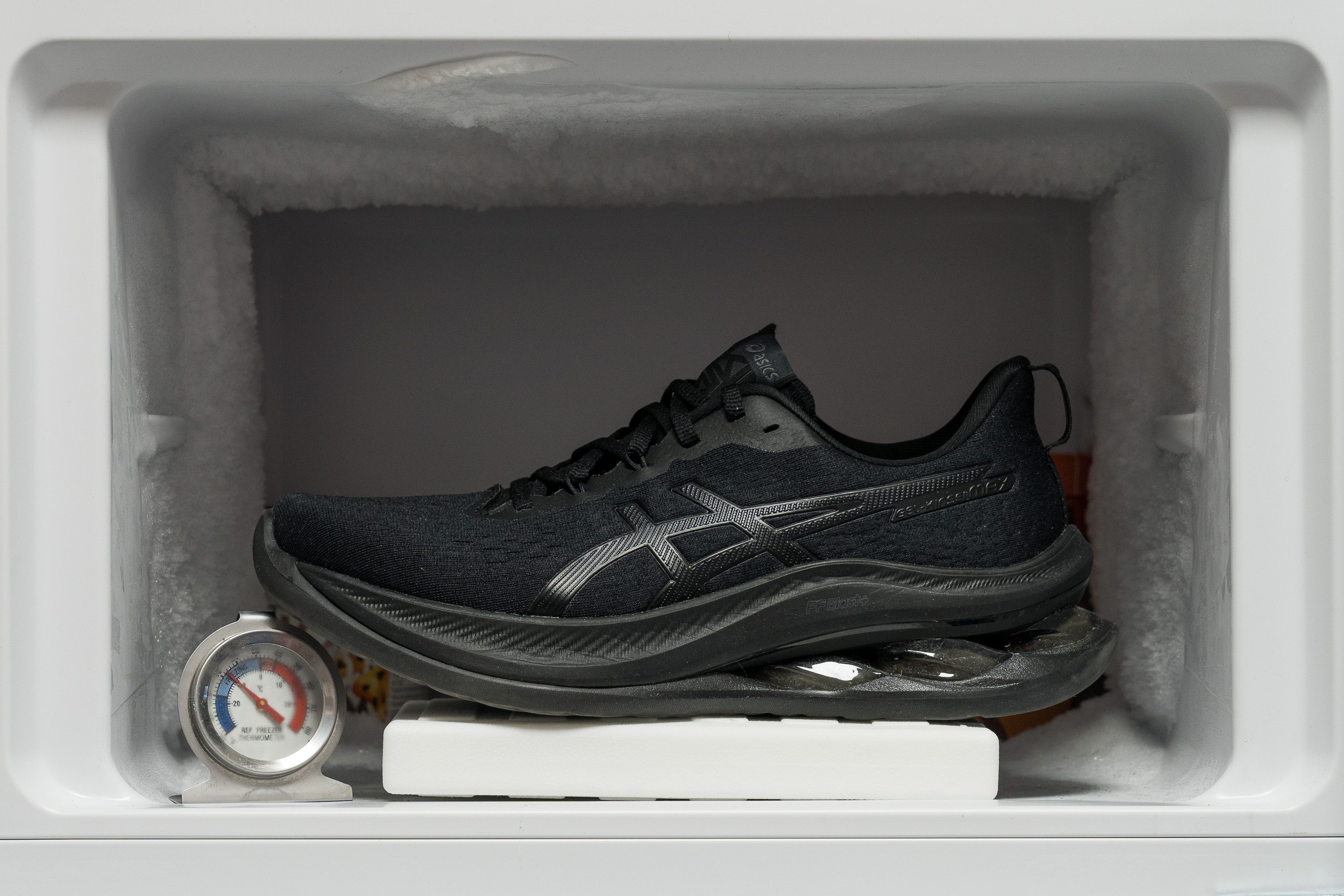
| Gel Kinsei Max | 16% |
| Average | 24% |
Reflective elements
We were glad to find reflective details on the heel of the Kinsei Max—something we believe every running shoe should include for added safety during low-light runs.
| Gel Kinsei Max | Yes |
Tongue padding
Despite the shoe’s substantial weight, the tongue is surprisingly thin.
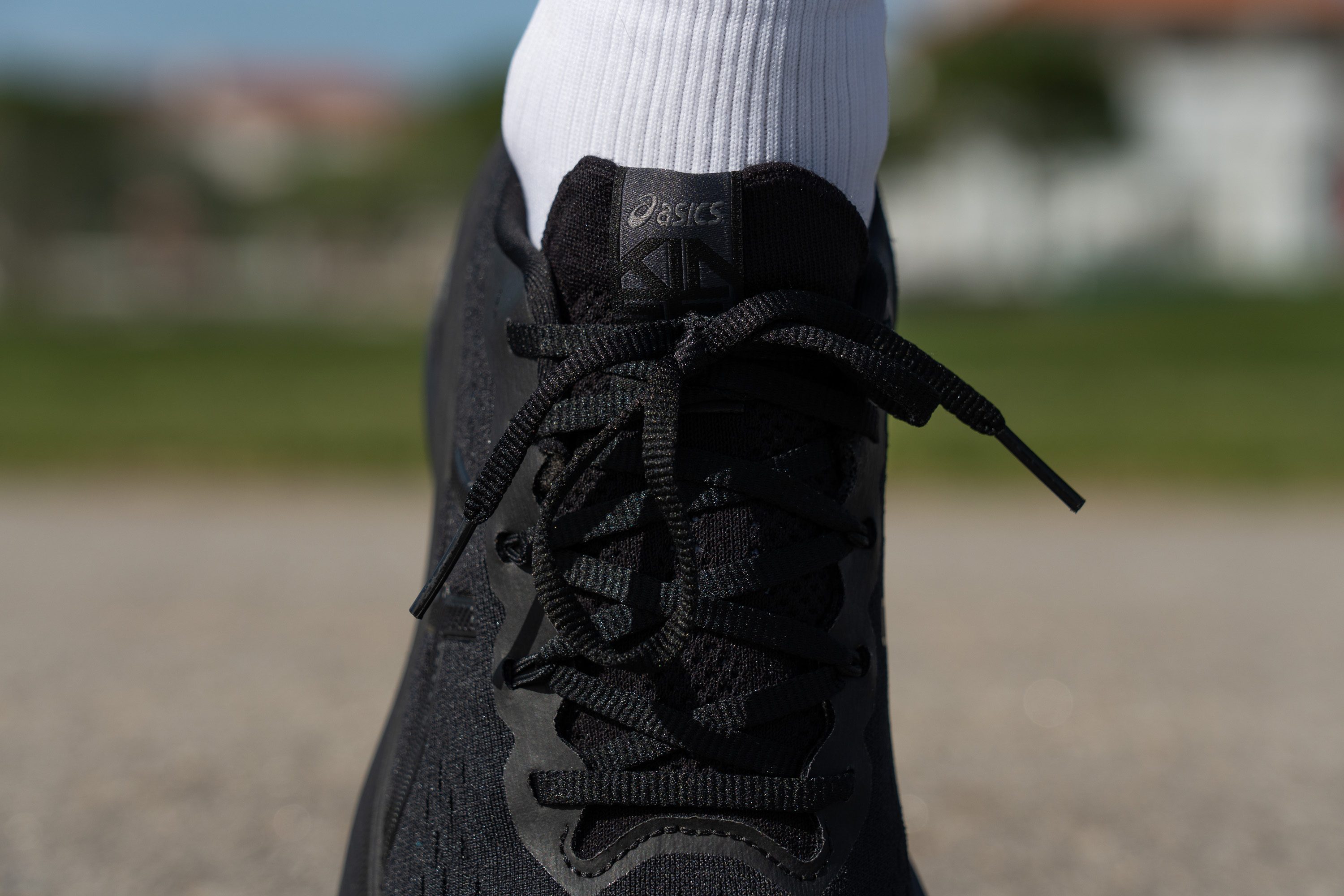
We measured just 2.6 mm of padding between the laces and the instep, which might feel lacking for runners seeking a plush, cushioned step-in experience.
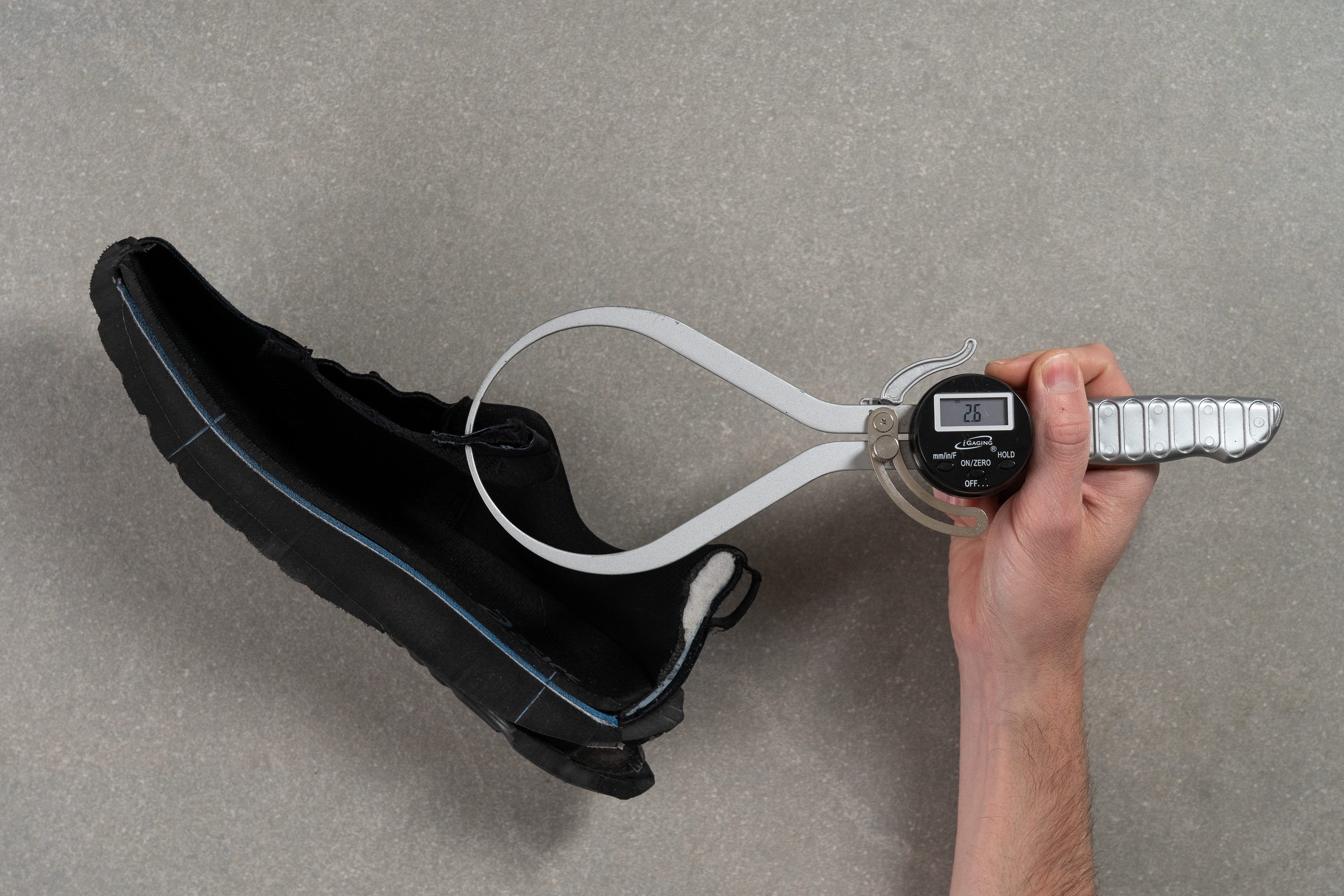
| Gel Kinsei Max | 2.6 mm |
| Average | 5.8 mm |
Tongue: gusset type
The tongue is attached to the sides—something we’ve come to expect at this price point. However, it’s hard to see due to the triple-black colorway we purchased, which was the only one available at the time.

| Gel Kinsei Max | Both sides (semi) |
Price
The Kinsei Max comes with a steep price tag that’s tough to justify. While the build quality and materials are great, they’re not groundbreaking compared to similarly priced options.
If you love GEL cushioning and aren’t bothered by the extra weight, it might still be a solid pick. Otherwise, we think most runners would be better off exploring alternatives or waiting for a price drop.
| Gel Kinsei Max | $180 |
Heel tab
The heel includes a handy finger-loop tab that also serves as a reflective element, as we showed in one of our previous tests.
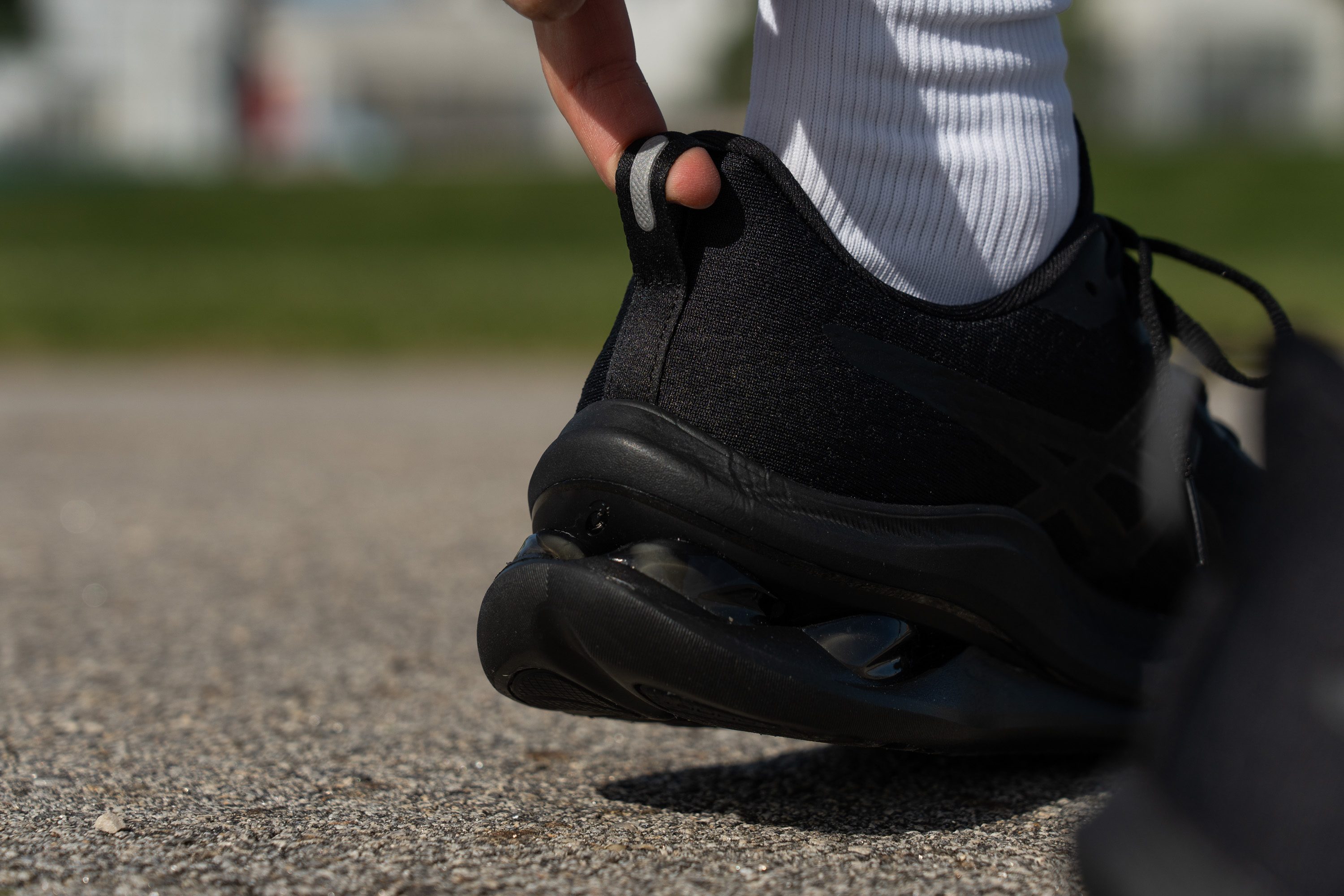
| Gel Kinsei Max | Finger loop |

